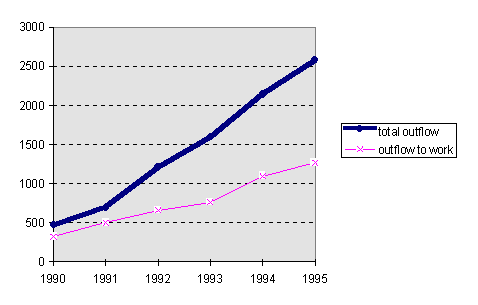
A Labor Perspective on Some Basic Issues of European Integration
9) A Labor Perspective on Some Basic Issues of European Integration
The pressures of globalization pose very intricate questions for the future of the European continent in the world economy. The optimistic version holds, that with NATO and EU extension, security is increased in the East of the continent, while the ups and downs of transformation produce tangible results for the great majorities of the population, stabilizing young democracies. Eastward expansion of the European Union will enhance growth and stability, while European Monetary Union will enhance Europe’s chances the international economy. Institutional reform of the Union will proceed, leading to a region of prosperity, peace and stability on the old continent. Monetary Union will end competitive devaluation circles, it will stabilize employment and growth, and will strengthen the European position in the long run.
At this stage, some general points should be permitted, that try to advance what I call here a ‘labor movement perspective’ on some of the basic problems of the future of European integration, but which, I concede, are also very well compatible with a thorough liberal critique of some of the basic assumptions of current European integration. Opinion in Europe among circles that identify themselves with ‘labor’ and with the ‘new social movements’ of the 1980s is at best divided over future integration policy, including the speed of EU eastward extension, while in America Wall Street and business is apprehensive or critical about the Union, and the left in North America largely overlooks the potential benefits of a successful European Union for the world economy. Researchers from the South, most notably Samir Amin (1997), have written committed, critical, alternative agendas for European integration. European success is necessary for an alternative agenda in world society.
To continue and develop this tradition, we start from the assumption that eastward expansion of the Union still could fail, because East European democracies become more ungovernable under the pressure of the world market; institution reform could fail, because the EU is - under the dominance of big-business and big agriculture lobbying - a stagnation-prolonging mechanism, and European Monetary Union could fail, because international capital is more and more a narco-capital that shifts around the world. Thus, this Chapter is meant to be a provocation, but it is meant as an honest provocation written by a committed European. Precisely because the present author believes in the political imperative of a social and politically United Europe, which could become an important factor of international peace and stability, east-west and north-south cooperation, trade and conflict management, a thorough critique of the ‘real existing Union’ must be allowed
The Chapter deals with the issues in a macro-quantitative fashion, trying to explain the performance of the countries of the world economy, of eastern and western Europe by their sets of initial policy-conditions. It presents evidence, based on UNDP and UNCTAD data series. It will be shown that
We present here some of the first cross-national tests of the transformation policy failure or success since the end of Communism in Europe in 1989. What are the lessons to be drawn from our knowledge about world societal ascent and decline?
The eastward expansion of the European Union
No one seriously doubts the necessity of world political security and market access for East Central Europe. Our view of EU eastward expansion is more somber: the end result should not be the re-peripherization of the Eastern half of the continent, that was all too familiar for the region during the capitalist development from the Long 16th Century to 1939. Thus, a perspective is taken up again, that is a classic theme of especially Polish sociology, especially in the works of Jadwiga Staniszkis. The average incidence of poverty in Eastern Europe - as defined by a daily income of $4 or less (measured in 1990 PPP$) - increased sevenfold between 1988 and 1994, from 14 million to more than 119 million. In Russia, over 60% of all children live below the poverty line. 66% of all Russians below the poverty line have jobs. Only 40% of workers were paid in full and on time (UNDP, 1997). The incidence of chronically malnourished children in Russia rose from 9% to 14% since 1992. The life expectancy of Russian males has fallen in five years to 58 years - in fact, it is lower than that of India today (61.1) (UNDP, 1997). 9 Eastern European reform states accumulated between 1992 and 1997 a negative current account balance to the tune of around $bn 50. The basic hypothesis of this Chapter is that the East of the European continent is threatened by Latin-americanization (Amin, 1997), and that a socio-liberal transformation alternative would soon have to be found. That this is not just dependendista propaganda, is to be inferred from a commentary from the Polish Press:
"In order to reduce the foreign trade deficit, it is necessary
to export more highly processed goods, which for the time being
account for a mere 5 percent of the value of Polish exports,"
Professor Urszula Plowiec said as the presented the annual report
of the Institute of Business Cycles and Prices on Poland's econom-
ic policy.
According to the authors of the report, the influence of
the state on foreign economic policy of the country is declining
and the economy is becoming increasingly dependent on interna-
tional organizations, such as the European Union, the World
Trade Organization or the OECD.
The report suggests that the state has not been doing
enough to promote the growth of exports. In particular, the state
should support exporters by financing export insurance policies
and guaranteeing export loans. "In highly developed countries, up
to 50 percent of exports are insured, compared to 1.5 percent in
Poland," one speaker pointed out.
One of the most serious foreign economic policy flaws,
according to the Institute, is the lack of coordination between the
opening up of the market and the restructuring of the economy.
The reduction of import duties on manufactured goods was not
accompanied by the adoption of protective clauses serving the
protection of domestic manufacturers from excessive imports,
including subsidized ones or ones offered at dumping prices.
The Institute estimates that customs protection of the
Polish market was reduced by up to 60 percent in the years 1995-97.
(Based on 7-8 June 1997 issues of Gazeta Wyborcza No. 131, p.
23; Dziennik Prawa i Gospodarki No. 51, p. 5).
Following the radical perspective, so brilliantly exposed by Claude Julien in Le Monde Diplomatique September 1996 and by Samir Amin (1997), the question cannot be how well countries like Poland adapted a blueprint, (for example, contained in the famous White Paper of the European Commission (1995)), but what contradictions, cleavages and conflicts arose within Eastern Europe and between Eastern Europe and the old West European centers in the process of globalization and the expansion of the market order into Eastern Europe after 1989. Or to put the problem in Osvaldo Sunkel’s terms: Eastern Europe saw a slow rise in the share of the gross product of foreign affiliates as a ratio to home country GDP (from 0.0% in 1982 to 1.3% in 1991), while the market-power of the transnational corporations saw to it, that the sales of foreign affiliates dominated an ever-growing share of the exports of goods and non-factor-services of the transition countries (the share went up from 0.9% in 1982 to 22.8% in 1993). The successive Governments of Poland - like the other governments of the region - have done a lot in the right directions for preparing the country for Union membership, but the framework of a semi-periphery country in the world economy creates pressures and instabilities which largely co-determine the social policy outcomes. Published social scientific evidence (UNDP, 1996, 1997 Human Development Report Poland) suggests, that the following basic and real conditions for Polish social policy still exist - the spurt of recent economic growth notwithstanding ((i) to (ix) all UNDP data). These conditions also explain the shifting cultures of protest voting in Poland - Tyminski in 1991, SLD and PSL in 1993, AWS in 1997:
(i) the number of employed in Poland is still smaller by 2.4 million persons in comparison with the end of 1989
(ii) the growth of employment in the private sector did not yet fully compensate the job losses in the public sector after 1989
(iii) 800000 to 1.1 million Poles work in the ‘hidden economy’
(iv) there was a long-term decline in the outflow from unemployment to official work in relation to the total outflow over recent years, only halted in 1997, suggesting that the hidden economy, illegal foreign labor, and other forms of existence compensated for the losses:
Graph 9.1: unemployment in Poland - total outflows and outflows to work, 1990-1995

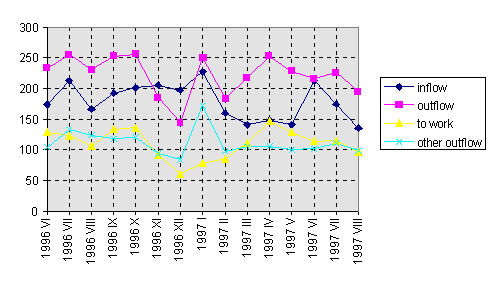
Legend: labor market statistics in Poland. Inflows to unemployment, outflows from unemployment (total, to work, and other outflow) in thousands of persons. Compiled from Central Statistical Office, Statistical Bulletin, September 1997
(v) youth unemployment remains very high and is in fact over 30%
(vi) 280000 persons are totally discouraged from looking for any kind of work, a trend which is exacerbated by the ever more stringent requirements to receive unemployment benefits
(vii) hidden unemployment on the farms also amounts to a large number of affected people, in all 450000 to 690000 persons. The total rural underclass comprises more than 5 million people
(viii) social insurance benefits paid from the national budget consume now 1/6 of the total GDP. By 2020, the number of pensioners will increase by yet another 3 million from 9 million persons to 12 million beneficiaries
(ix) several studies suggest, that the social policy frame of reference for the disabled persons in Poland is still not satisfactory (UNDP, 1996). There are over 4000000 disabled persons in Poland. 60% of them only have the most basic educational level, making this group of people even more vulnerable on the labor market. The majority of disabled persons in Poland is professionally inactive. In 1995, the unemployment rate of disabled persons in the cities was 28.1%, while in the countryside it was only 6.2%. Young disabled male persons under 24 years of age have an unemployment rate of more than 50% (UNDP, 1996: 88). Almost 43% of the households of disabled persons assert that they can only afford the cheapest food and clothing. Over half are indebted and have difficulties with the repayment of debts. As many as 43% assert that they lack means for basic medicines and treatment. 85% of all disabled feel themselves excluded from the means of public transportation. Pollution and low access to medical care in the countryside determine, that 39% of all disabled persons live in the villages
There are widely differing estimates about poverty in Eastern Europe. Our own view is that a policy of investment in human capital could fairly quickly redress the existing imbalances, and at the same time help the country to avoid double deficits and a rising dependence from foreign capital.
What way out from the transformation trough, from poverty and dependence a country should choose? The debate about Eastern European reconstruction seems to be dominated by several fallacies. The first fallacy would concern the famous hypothesis about the 'market economy without adjective nouns' as an engine of a successful transformation process. Following the logic, already proposed by Adamczyk, 1992; Angresano, 1994 and Jenkins, 1987, a de-facto policy of mass demand maintenance might have been better adapted to survive the transformation shocks and might - in the end - have been even more profitable for large-scale TNC investment than the real 'shock therapy strategies'. The second fallacy concerns the workings of foreign capital in the region and in the development process. Simple macro-economic reasoning would already demonstrate, that a sound economy, based on dynamic export-growth and huge positive trade and service balances, tends to be an overall capital exporter and not a capital importer. However, to paraphrase current bankers’ language, Eastern Europe wants historic East Asian growth rates at African savings rates. The result is of course, neo-classics and dependentistas will agree, increased foreign capital imports in a relatively backward economic structure. The rest already has been described by Gunnar Myrdal in full detail. The macro-economic need for high net foreign investment, hence the predominance of foreigners investing at home as compared to the investments of nationals abroad on the enterprise level, precisely arises, when either export-led growth is insufficient or import-substitution strategies are in force or both. Everything that has been said over the last thirty years about globalization can also be interpreted in terms of a radical neo-classic critique of import-substitution policies and insufficient export-oriented strategies (Ernst, 1973). The East, hoping to attract foreign capital to the detriment of the relative share of the developed countries, in world investment flows must ask itself, whether or not low labor costs are a necessary let alone a sufficient condition to attract foreign capital.
The 9 most promising reform countries increased their total debt from 101 billion $ in 1992 to 127,2 billion $ in 1995. The present author thus expects a renewed East European debt cycle as entirely likely. The right wing in Poland contends - not without justification -, that the left which governed Poland from 1993 to 1997, incurred a trade balance deficit to the tune of 22 billion $ since taking power to the end of their regime. That their own policy of unilateral opening of markets, 1989 - 1993, contributed to the process, is another matter. In fact, one could even argue that there was no such thing as Western aid to the East at the early stages of the transformation, especially to some transformation economies in Europe. Talks about the Marshall plan were relatively belated on May 28, 1997; in fact, such a plan - and its philosophy - would have been necessary 9 years ago. Regimes that received real net transfers were the (former) 'real socialist' regimes of various Marxist or 'real socialist' denominations in the South and in the (former) USSR, but not all the transformation economies of Eastern Europe. Western protectionism, transfer pricing and other monopoly practices are to be held partially responsible for the fact, that aggregate net transfers to the East (after due consideration of interests paid for Western Banks, donors and profits, paid out to investors) were sometimes negative (our own compilations from Vienna Institute for International Economic Comparisons; World Bank, WDR (1994), HDR UNDP, 1994, and Business Central Europe, July 1997). Although later data (World Bank, WDR, 1996) seem to suggest a certain reversal in the trends of the international division of labor within Europe, it is pretty certain that the whole region, from 1990 to 1995, received only 15% of all total investment inflows to the tune of $1640 thousand million (World Bank, WDR, 1996). The World Development Report 1996 clearly states:
‘One might have expected huge imports of capital, both private and official, to participate in financing the costly economic and political transformation (...) However, except for the former East Germany (i.e. $700 thousand million), CEE and the NIS have not absorbed a great deal of foreign capital - either private investment flows or official external assistance (...) Between them the countries of CEE and the NIS absorbed 15 percent of total capital flows to developing and transition countries (...) Net resource inflows are much lower and even negative to some countries, once debt service and capital flight are taken into account. Capital flight from Russia alone has been estimated at some $50 billion (i.e. thousand million) for 1992-95, although part of this represented capital exported through Russia from other NIS (...) In 1994, FDI to CEE and the NIS was only $6.5 billion (i.e. thousand million), equivalent to the total received by Malaysia and Thailand (...) The Visegrad countries received fully three-quarters of the total, whereas many other countries in the region are still all but untouched by foreign investment (...) All in all, then, transition has not absorbed a large slice of global capital flows (...) Aid under the Marshall Plan after World War II averaged 2.5 percent of the incomes of the recipient countries at the time. Total official disbursements to the CEE economies, which have generally progressed furthest in their reforms, accounted on average for about 2.7 of their combined GDP in 1991-93. Under-recording of GDP in these economies may bias this ratio upward, but on this measure Marshall Plan disbursements were not materially larger (...) The Marshall Plan did, however, embody a larger grant element, and it was much more generous relative to the donor economy’s income, at 1.5 percent of U.S. GDP.’ (World Bank, World Development Report, 1996: 136 and 10)
Thus, there is a certain evidence on a de-facto de-capitalization of the transition countries:
Table 9.1: The Amin hypothesis about the Latin Americanization of Eastern Europe. Current account balances from 1992 onwards in the region
|
1992 |
1993 |
1994 |
1995 |
1996 |
1997 |
Country Total |
|
|
Bulgaria |
-361 |
-1098 |
-32 |
-43 |
100 |
200 |
-1234 |
|
Croatia |
823 |
104 |
103 |
-1712 |
-1100 |
-1000 |
-2782 |
|
Poland |
-269 |
-2329 |
-944 |
-2299 |
-400 |
-2000 |
-8241 |
|
Romania |
-1564 |
-1174 |
-428 |
-1292 |
-1000 |
-1000 |
-6458 |
|
Slovak R. |
-601 |
665 |
646 |
-1300 |
-1500 |
-2090 |
|
|
Slovenia |
926 |
192 |
540 |
-36 |
-150 |
-200 |
1272 |
|
Czech R. |
115 |
-50 |
-1892 |
-3400 |
-3700 |
-8927 |
|
|
Ukraine |
-621 |
-854 |
-1396 |
-1545 |
-1200 |
-1200 |
-6816 |
|
Hungary |
324 |
-3455 |
-3911 |
-2480 |
-1800 |
-1700 |
-13022 |
|
Annual Total |
-742 |
-9100 |
-5453 |
-10653 |
-10250 |
-12100 |
-48298 |
Legend: CEEC 7 comprises the Czech Republic, Hungary, Poland, the Slovak Republic, Slovenia, Bulgaria, and Romania. From: Vienna Institute for International Economic Comparisons, Monatsberichte des Oesterreichischen Instituts fuer Wirtschaftsforschung, 5, 1997
Although earlier studies, among them Chase-Dunn, 1982, Szlajfer, 1977 and Tausch, 1985, already stressed the world-market dependent character of 'real socialism', the flow of direct foreign investments increased significantly only after the fall of the Berlin Wall in 1989. Russia and Hungary received the lion's share of western capital flows to the East. Foreign capital in the Polish economy, that perennial testing ground for beliefs of all sort over the last millennium, is estimated to amount to 12.0277 billion $ (Paiz); the inflows 1989-97 were small however, compared to the massive flows of TNC capital to countries like China. After the Asian crash of autumn 1997, an increased amount of speculative capital flows into the country. The Italian Mafia is said to launder 100000 $ per hour in Poland - that will not make the financial system more stable either (Polityka, 16, 1998). A repetition of the all too famous ‘tequila effect’ seems to be likely. Business Central Europe estimates, that Poland ranks fifth in terms of per-capita foreign direct investment stock in the region, surpassed by Hungary, Slovenia, the Czech Republic, and Estonia. The FDI stock as percentage of GDP in 1994 was already 5.1%, while in Brazil it was 8.0%. Poland even paid aggregate net transfers to the West during the Solidarity years 1989-1993. And here, the third fallacy about post-1989 reconstruction arises: some Eastern countries were at the crucial time of the political transition in an increasingly precarious position vis-à-vis the centers of the transnational economy, just like the predecessor regimes in the region in the 1920s and 1930s and the countries of the periphery today. Aggregate net transfers are understood as aggregate net resource flows minus interest payments on long-term loans and remittance of all profits. Aggregate net resource flows are the sum of net flows on long-term debt (excluding use of IMF credit), plus official grants (excluding technical assistance) and net foreign direct investment. That is to say, Poland (just as Hungary), in reality, were de-capitalized by the world economy, when the new elites in power would have needed Western support most urgently (World Bank, WDR, 1994). As we will show below, the workings of the transnational economy did probably contribute to the political cleavages and to the downfall of the Solidarity government in 1993. The yearly de-capitalization amounted to 27 million $. The share of foreign investment per total GDP, i.e. the value of the index, what Bornschier and Mueller (1988) call 'foreign property', was anywhere around 8.5% for the overall Polish economy in 1995 (UNCTAD, 1996). In terms of the employment effects, one finds that transnational capital now controls the most important modern, dynamic consumer goods sectors; 2.7% of the total labor force and 6.8% of all workers and employees in industry work for international firms. The private sector is dominated to a still larger degree by foreign firms; 16% of the labor force in private industry in fact works for foreign firms.
The fourth fallacy concerns the effects of 'dependent development' on the host countries. The employment effects of transnational investments were over- the socially polarizing effects of transnational investments underestimated. Regional concentration of development increases, and with that the political cleavages of a basically still semi-peripheral society. Even for the case of China, the World Bank WDR 1996 states:
‘FDI to China was $33.8 billion (i.e. thousand million) in 1994, second only to flows to the United States. However, a substantial portion consisted of domestic funds recycled as foreign investment to take advantage of fiscal concessions’ (World Bank, WDR, 1996: 136)
A Polish regional case study
Poland's position in the world is first of all confronted by the fact, that since 1989 all her neighbors have changed - only the Baltic seacoast has remained the same. East Germany to the East has disappeared and has been reunited with West Germany, Czechoslovakia to the South has separated into the Czech and the Slovak Republics, and to the East, the USSR dissolved - leaving the Ukraine, Belarus, Lithuania, and Kaliningrad oblast, pertaining to Russia, behind. The development effort of the West in such a world politically highly sensitive region - and especially TNC investment - is concentrated around the rich centers of Poland, like Warsaw, Gdansk, Katowice, Krakow, Poznan and Wroclaw. A similar picture arises from the other transformation countries. The poor rural regions of Poland are almost totally neglected by foreign capital; some run-away industries are growing up in the western regions, bordering the Federal Republic of Germany. From Central Statistical Office data we estimate, that the difference between the richest and the poorest voivodship is for:
|
infant mortality |
1:1.9 |
|
inhabitants per doctor |
1:3.4 |
|
inhabitants per hospital bed |
1:2.3 |
|
telephones per inhabitants |
1:3.5 |
|
cancer death rate |
1:1.7 |
|
unemployment |
1:4.1 |
|
investment per capita |
1:4.2 |
Legend: our own compilations from Polish Central Statistical Office data
The transformation after 1989 destroyed more than 3 million jobs in the public sector and more than 150 000 jobs in private agriculture, mainly in the East and the North of the country; in comparison to that, the performance of private national and or foreign capital in creating jobs has been more than modest from 1989 to 1994:
|
1989 |
1994 |
growth/decl. |
|
|
public sector |
9277,8 |
5878,4 |
-3399,4 |
|
private agric. |
3898,7 |
3744,9 |
-153,8 |
|
foreign cap. |
130,4 |
228,1 |
97,7 |
|
other priv sec. |
4082,5 |
4881,8 |
799,3 |
Source: our own calculations from G.U.S. Rocznik Statystyczny Pracy 1995
In a way, development of capitalism in Poland meant first and foremost an increase of the reserve army - and of the second economy, now amounting to 43% of the Polish GDP (Economist, The World in 1998). Statistics from the Polish press indicate the following distribution of foreign direct investment in Poland in 1997 (more recent data are also to be found in Chapter 8 of this study):
Graph 9.2: MNC investments in the Polish economy
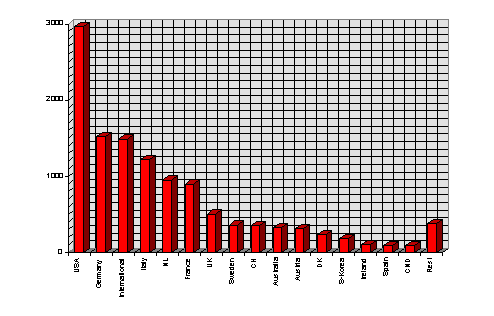
Legend: stock of MNC capital by country of origin
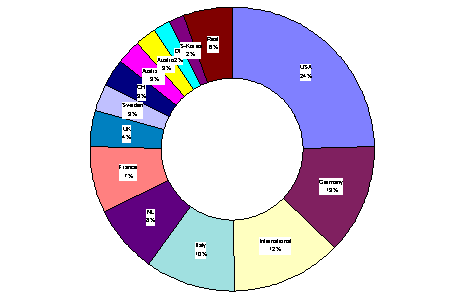
Legend: breakdown of foreign investors in percent. Source: our own compilations from Polish Agency for Foreign Investment (PAIZ), for December 1996, as published in Okecie Airport Magazine, April 1997, 4: 5
Now, Poland was hit by the worst floods in human memory during summer 1997. The most dynamic regions of the country, around Wroclaw and further to the North-west, but also in Upper Silesia, were devastated by the flood waters. Social science, under such conditions, can only guess the consequences, but they are thought to be far-reaching, insofar as the psychological impact on the population, that was about to gain the first real fruits of transformation, must be very negative and long-lasting. The floods, furthermore, have exposed many of the weaknesses of the administrative centralist structure in such fields as environmental policy, sewage disposal, garbage collection, and infrastructure. International and Polish press reports suggest that basic initiatives by neighborhood committees emerged in the South and South-west under the impression of prime ministerial arrogance, rotting animal corpses and broken sewage pipes, thus challenging again the ‘centralist’ authority of the Polish state, perhaps marking the beginning of yet another 12 to 14 year cycle of protest and dissatisfaction, that is so typical of Polish history since the re-founding of the Polish state within today’s borders in 1944/45 (1956, 1968 - 1970, 1980 - 1983). It is interesting to note, that there is a vague temporal correlation of this Polish protest cycle with the Kuznets and or Kondratieff cycle troughs since 1945 in the periphery (with the western troughs in the years 1958, 1975, 1981). Although the Polish economy seems to be still in full swing for the moment, the relationship of trust between the governed and the government tilted against the latter in the September election of 1997, and the foreign balances of the economy point in a downward direction. Again, as in 1989, a triumphant labor movement, Solidarity, is supposed to push through an austerity course while in government. Such a Polish political tango could remind us, if a lot goes wrong, rather of Argentina in the 1960s, 1970s, and 1980s. Regional unemployment in Poland is relatively stable and is a clear indicator of the semi-peripheral character of the country in the world economy:
Graph 9.3: unemployment in Poland - regional aspects
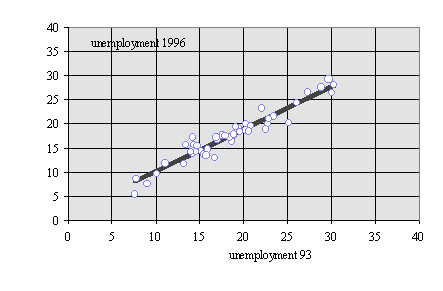
Legend: unemployment rate 1993 (x-axis) and unemployment rate 1996 (y-axis), based on G.U.S. statistics on unemployment in the 49 voivodships of Poland.
The multiple regression to explain the residuals from the above Graph works with the following variables taken from the Polish Central Statistical Office and from the daily Polish Press:
big estates per total land
employment in agriculture
employment in foreign capital enterprises per total employment
employment in mixed enterprises per total employment
external migration per total population
female excess infant mortality rates (based on regression residuals of male on female infant mortality rates in the different voivodships of the country). Voivodships are said to have an excess female infant mortality, when the regression residual is positive)
human development index
industrial employment
industrial waste
private land per total land
real GDP per capita
religious practice
urbanization
voting data on a voivodship level for all the elections and referenda since 1993, compiled from the Polish dailies
wage level
During the post-communist years, there was a clear ‘political’ economy of castigating the opposition strongholds and handing out benefits to one’s own political folk:
equation (9.1) the rise or fall of unemployment in Poland 1993/97:
|
-0,005 |
0,33 |
-2,422 |
0,649 |
4E-05 |
0,126 |
-0,097 |
0,05 |
-0,033 |
-0,083 |
-0,002 |
0,076 |
-0,501 |
|
0,047 |
0,603 |
0,979 |
10,43 |
5E-04 |
0,088 |
0,036 |
0,048 |
0,018 |
0,067 |
0,006 |
0,043 |
8,071 |
|
0,45 |
1,177 |
|||||||||||
|
2,453 |
36 |
|||||||||||
|
40,82 |
49,91 |
T-test |
||||||||||
|
-0,105 |
0,547 |
-2,47 |
0,062 |
0,079 |
1,429 |
-2,71 |
1,04 |
-1,91 |
-1,244 |
-0,378 |
1,756 |
constant |
|
religious pract |
ext migr/pop |
PSL |
private land |
peasants |
big estates |
SLD |
real gdp pc |
HDI-index |
for cap pen |
mixed cap pen |
2tour Walesa |
|
Note: as in all EXCEL 5.0 outprints, first rows are unstandardized regression coefficients, second rows are standard errors of the estimate, the third row shows the value for R^2 of the whole equation and the standard deviation of the estimate for y; the fourth row are the F-value and the degrees of freedom of the whole equation; the fifth row shows the sum of squares of the regression and the sum of square of the residuals.
In Tausch (1997) it was shown that the post-communist SLD clearly emerged in the period 1993-95 as a party in regions with a high amount of environmental damage, and in rural regions with low industrialization and excessive sexist patterns of mortality. The post-communists clearly lost in 1993 and 1995 in terms of electoral support due to a higher penetration of a region by foreign capital. The radical right, not represented in the Sejm between 1993 and 1997, was especially strong in regions of low urbanization, industrialization and high external, poverty-driven migration. In 1997, this potential increased dramatically, especially in the aftermath of the Papal visit to Poland and the flood disaster, which, many people believe, was managed very badly during the first few days by the Central Government in Warsaw. With the disintegrative tendencies of the right-wing-liberal-trade-unionist coalition, formed after the 1997 election, on the increase, this protest potential will perhaps shift to other, as yet unknown formations.
Urban, less traditionally catholic, and less private-peasantry-oriented and less big landholding areas were far more attractive to transnational capital than the traditional Polish countryside, while joint ventures prefer urban low-wage areas of Poland, also characterized by the absence of a numerically strong private (and conservative) peasantry. The main results of the above analysis also hold for the constitutional referendum of May 25th 1997. The results are a neat reproduction of the second round of the presidential elections in 1995, as is to be shown from the following graph:
Graph 9.4: The regionally constant pattern of voting in Poland - the second round of the presidential elections in 1995 as a determinant of the ‘NO’-vote in the constitutional referendum of May 25th 1997:

Legend: the Walesa-vote 1995 (x-axis) and the constitutional vote 1997 (y-axis) as dependent variables, based on the 49 voivodships of Poland. Our own compilations from the official election/referendum results, as published in the daily Polish Press.
The 1997 referendum again showed the political cleavages of the country: the catholic, foreign-capital penetrated regions voting with the political right, while the semi-peripheral regions of the Northwest and Northeast, characterized by big landholding before 1918, voting with the political left. However, the time perspective reveals another tendency. The AWS-Solidarity alliance in the fall 1997 parliamentary elections could relatively increase its vote in regions, characterized by big landholding before 1918, and also in regions, characterized by paternalistic patterns of excess female infant mortality rates. These are the regions, where dependent development has the biggest contradictions. Precisely there, the left showed its weaknesses well before the election of the 21st of September 1997, when four years of left government in Poland ended:
Table 9.2: the determinants of the 1997 referendum on the constitution
|
Variables |
religious pract |
ext migr/pop |
industr waste |
private land |
peasants |
big estates |
fem exc inf m |
real gdp pc |
hdi-index |
for cap pen |
mixed cap pen |
constant |
|
NO-Vote |
6,896 |
-6,435 |
65,98 |
-0,002 |
-0,004 |
-0,357 |
0,105 |
0,056 |
-1E-04 |
0,049 |
0,951 |
-22,77 |
|
1997 |
3,614 |
6,955 |
63,42 |
0,002 |
0,005 |
0,202 |
0,197 |
0,106 |
7E-05 |
0,042 |
0,215 |
44,31 |
|
0,674 |
||||||||||||
|
6,96 |
37 |
|||||||||||
|
t-test |
1,908 |
-0,925 |
1,04 |
-0,902 |
-0,665 |
-1,77 |
0,534 |
0,526 |
-1,402 |
1,174 |
4,432 |
-0,514 |
increases/decreases of the anti-SLD-protest vote in %
|
Variables |
religious pract |
ext migr/pop |
industr waste |
private land |
peasants |
big estates |
fem exc inf m |
real gdp pc |
hdi-index |
for cap pen |
mixed cap pen |
constant |
|
increase |
-3,67 |
-4,801 |
-2,089 |
-4E-04 |
-0,002 |
0,322 |
0,635 |
3E-04 |
1E-04 |
-0,074 |
-0,187 |
-12,11 |
|
decrease/ protest |
3,554 |
6,841 |
62,38 |
0,002 |
0,005 |
0,198 |
0,193 |
0,104 |
7E-05 |
0,041 |
0,211 |
43,58 |
|
0,742 |
||||||||||||
|
9,654 |
37 |
|||||||||||
|
t-test |
-1,032 |
-0,702 |
-0,033 |
-0,179 |
-0,37 |
1,622 |
3,286 |
0,003 |
1,424 |
-1,8 |
-0,887 |
Legend: our own compilations from the above mentioned data. Anti-SLD-protest vote: 1995 presidential election vote for Lech Walesa; 1997 ‘NO’ at the constitutional referendum. As in all EXCEL 5.0 outprints in this work, first row: unstandardized regression coefficients, second row: standard errors, last row: t-Test. The values immediately below the standard errors are R^2 (third row, left side entry), F, and degrees of freedom (fourth row).
The 1997 general election, in turn, repeated the results of the referendum and the 1995 general election. Both large political camps show a very surprising degree of homogeneity:
Graph 9.5: Voting 1995 and 1997

Legend: Walesa vote, 1995 (x-axis) and AWS-vote, 1997 (y-axis), based on the 49 voivodships of Poland.
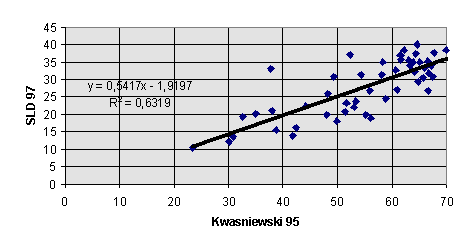
Legend: the Kwasniewski vote (1995) (x-axis) and the SLD vote (1997) (y-axis), based on data about political performance in the 49 voivodships of Poland.
The Solidarity-led AWS was especially strong in regions with mixed foreign capital presence, while the post-communist SLD had the following significant factors working in favor or against it:
positive influences on the SLD vote:
negative influences on the SLD vote:
The SLD as the party of the ‘modernizing state class’ could still - relatively - hold its place in regions with high human development and in the typical northern agricultural zones, characterized before 1939 by Junker German big landholding, although a great number of their potential voters stayed at home, thus increasing the voter abstention rate; whereas the left-wing defeat in the traditional small-scale peasantry regions of the East and South-east was almost total. These regions are characterized by high female excess infant mortality rates and by traditional religious patterns. The SLD also significantly lost in the ‘modern’ regions with high foreign capital and mixed capital presence.
Table 9.3: the 1997 general election in Poland
|
Variables |
religious pract |
ext migr/pop |
industr waste |
private land |
peasants |
big estates |
fem exc inf m |
real gdp pc |
hdi-index |
for cap pen |
mixed cap pen |
constant |
|
AWS |
4,797 |
4,317 |
30,485 |
-0,001 |
-0,006 |
-0,255 |
-0,077 |
0,0713 |
-3E-05 |
0,02 |
0,8388 |
-7,098 |
|
3,3637 |
6,4739 |
59,032 |
0,0022 |
0,005 |
0,1877 |
0,1829 |
0,0984 |
6E-05 |
0,0387 |
0,1998 |
41,239 |
|
|
0,556 |
||||||||||||
|
4,22 |
37 |
|||||||||||
|
t-test |
1,4261 |
0,6668 |
0,5164 |
-0,502 |
-1,111 |
-1,359 |
-0,42 |
0,7242 |
-0,497 |
0,5187 |
4,199 |
-0,172 |
|
religious pract |
ext migr/pop |
industr waste |
private land |
peasants |
big estates |
fem exc inf m |
real gdp pc |
hdi-index |
for cap pen |
mixed cap pen |
constant |
|
|
SLD |
-4,251 |
3,4467 |
-51,91 |
0,0011 |
0,007 |
0,2615 |
-0,257 |
-0,034 |
7E-05 |
-0,071 |
-0,512 |
85,714 |
|
2,0753 |
3,9943 |
36,421 |
0,0013 |
0,0031 |
0,1158 |
0,1129 |
0,0607 |
4E-05 |
0,0238 |
0,1233 |
25,443 |
|
|
0,773 |
||||||||||||
|
11,454 |
37 |
|||||||||||
|
t-test |
-2,05 |
0,8629 |
-1,425 |
0,7979 |
2,245 |
2,257 |
-2,27 |
-0,563 |
1,766 |
-3 |
-4,15 |
3,3688 |
|
religious pract |
ext migr/pop |
industr waste |
private land |
peasants |
big estates |
fem exc inf m |
real gdp pc |
hdi-index |
for cap pen |
mixed cap pen |
constant |
|
|
inc S |
-4,018 |
14,117 |
-19,34 |
-2E-04 |
-0,006 |
0,2304 |
0,2147 |
0,0072 |
0,0002 |
-0,083 |
0,0997 |
-24,18 |
|
3,5634 |
6,8583 |
62,537 |
0,0023 |
0,0053 |
0,1989 |
0,1938 |
0,1042 |
7E-05 |
0,0409 |
0,2116 |
43,688 |
|
|
0,364 |
||||||||||||
|
1,9257 |
37 |
|||||||||||
|
t-test |
-1,127 |
2,058 |
-0,309 |
-0,078 |
-1,149 |
1,1583 |
1,1081 |
0,069 |
2,509 |
-2,03 |
0,4712 |
-0,553 |
|
religious pract |
ext migr/pop |
industr waste |
private land |
peasants |
big estates |
fem exc inf m |
real gdp pc |
hdi-index |
for cap pen |
mixed cap pen |
constant |
|
|
incr SLD |
0,7107 |
9,9122 |
-40,32 |
0,0007 |
0,0063 |
0,0413 |
-0,625 |
0,0736 |
2E-05 |
-0,043 |
-0,082 |
-5,751 |
|
1,9507 |
3,7544 |
34,234 |
0,0013 |
0,0029 |
0,1089 |
0,1061 |
0,0571 |
4E-05 |
0,0224 |
0,1159 |
23,916 |
|
|
0,8702 |
||||||||||||
|
22,541 |
37 |
|||||||||||
|
t-test |
0,3644 |
2,64 |
-1,178 |
0,562 |
2,149 |
0,3796 |
-5,89 |
1,2903 |
0,5802 |
-1,93 |
-0,705 |
-0,24 |
|
religious pract |
ext migr/pop |
industr waste |
private land |
peasants |
big estates |
fem exc inf m |
real gdp pc |
hdi-index |
for cap pen |
mixed cap pen |
constant |
Legend: our own calculations from the above mentioned variables and the election results, as reported by http://www.prokom.pl, the web-site of a Polish electronics company, managing the calculation of the official results for the Polish Government. As in all EXCEL 5.0 outprints in this work, first row: unstandardized regression coefficients, second row: standard errors, last row: t-Test. The values immediately below the standard errors are R^2 (third row, left side entry), F, and degrees of freedom (fourth row).
Thus, still 2/3 up to ¾ of Polish voting are being determined by the structural characteristics of social policy and the insertion of Poland into the capitalist world economy. On the other hand, 71% of TNC employment and 38% of joint venture employment per total employment are explained by our equations:
Table 9.4: the political ecology of foreign capital attraction to the different regions in Poland, 1993
|
Explan. Var. |
employment for multinat corporations |
Joint ventures |
|
of/ region |
explains (ceteris paribus) 1993: |
|
|
employment in TNCs |
joint ventures |
|
|
wage level |
- |
|
|
Catholicism |
- |
|
|
migration |
||
|
ecological crisis |
||
|
private land |
- |
- |
|
traditional |
||
|
employment in |
||
|
agriculture |
||
|
big landholding |
- |
|
|
patriarchical |
||
|
structures |
||
|
industrial |
||
|
employment |
||
|
urbanization |
+ |
|
|
R^2 |
71% |
38% |
Source: Our own calculations (EXCEL 4.0 multiple regression IBM PS 2 notebook N51 SX) from C.S.O. data
Polish unemployment is a typical phenomenon of low-wage regions with either high pollution or high agricultural employment. Foreign capital does contribute to a better employment record, but the effect is not significant. The effect on life expectancy is even negative, although not significant. We again use the standard functions for life expectancy determination. Thus, the societal expectations created by globalization are not met:
equation (9.2) unemployment in Poland = 26.02 - 4.18 * wage level - 1.50 * religious practice - 0.06 * outward migration + 0.24 * industrial waste - 0.00 private land + 0.58 * employment in agriculture - 0.08 * big estates + 0.04 * excess mortality + 0.00 * industrial employment - 0.02 urbanization - 0.15 * foreign capital penetration (t-value 1.5911) - 0.003 mixed capital penetration
R2 = 73.39%; F = 8.27; df. = 36; a (one-tailed) 5% > 1.69
External migration, the well-known function of income level and human development, and the level of urbanization co-determine life expectancy in Poland. On the other hand, there is a really perverse negative determination of life quality variables, like life expectancy and infant mortality, by the number of doctors per voivodship, indicating the gross inefficiencies of the health system of the country:
Table 9.5: human development on a regional level in Poland, as being determined by socio-political processes
life expectancy in Poland
=|
gdp^1/e^2 |
gdp^ln( p) |
religious pra |
ext mig/pop |
industr waste |
private land |
peasants |
big estates |
fem exc inf m |
ind.employm |
urbanisation |
for cap pen |
mixed cap constant |
|
|
0,25896 |
-0,9082 |
-0,0069 |
-0,0322 |
-0,0002 |
-0,021 |
-0,0046 |
0,00597 |
-3E-06 |
-0,0028 |
0,04318 |
-6E-05 |
3,45214 |
62,2839 |
|
0,23142 |
0,4564 |
0,01614 |
0,01467 |
0,00035 |
0,0138 |
0,02232 |
0,00741 |
4,8E-06 |
0,00259 |
0,01309 |
9,6E-05 |
4,52338 |
12,6892 |
|
0,70286 |
0,47696 |
||||||||||||
|
6,36843 |
35 |
||||||||||||
|
18,8341 |
7,96228 |
||||||||||||
|
gdp^1/e^2 |
gdp^ln( p) |
religious pra |
ext mig/pop |
industr waste |
private land |
peasants |
big estates |
fem exc inf m |
ind.employm |
urbanisation |
for cap pen |
mixed cap pen |
|
|
1,119 |
-1,9898 |
-0,4305 |
-2,1946 |
-0,4549 |
-1,5236 |
-0,2052 |
0,80583 |
-0,6114 |
-1,0641 |
3,29921 |
-0,6334 |
0,76318 |
constant |
life expectancy in Poland as determined by health policy data =
|
doctors per pop |
hospital beds |
|
|
-0,053 |
0,0547 |
72,862 |
|
0,0159 |
0,0216 |
0,5609 |
|
0,1947 |
0,6849 |
|
|
5,5621 |
46 |
|
|
5,2182 |
21,578 |
|
|
-3,333 |
2,5321 |
t-test |
|
doctors per pop |
hospital beds |
|
infant mortality in Poland =
|
gdp^1/e^2 |
gdp^ln( p) |
religious pra |
ext mig/pop |
industr waste |
private land |
peasants |
big estates |
fem exc inf m |
ind.employm |
urbanisation |
for cap pen |
mixed cap pen |
constant |
|
-0,1869 |
-2,2702 |
0,13882 |
-0,0374 |
0,00096 |
-0,0412 |
0,07048 |
-0,0257 |
-2E-05 |
0,00162 |
0,00825 |
0,00011 |
-8,46 |
32,2124 |
|
0,87801 |
1,73163 |
0,06122 |
0,05565 |
0,00132 |
0,05235 |
0,08467 |
0,02813 |
1,8E-05 |
0,00981 |
0,04965 |
0,00037 |
17,162 |
48,1437 |
|
0,29022 |
1,80963 |
||||||||||||
|
1,10082 |
35 |
||||||||||||
|
46,864 |
114,616 |
||||||||||||
|
gdp^1/e^2 |
gdp^ln( p) |
religious pra |
ext mig/pop |
industr waste |
private land |
peasants |
big estates |
fem exc inf m |
ind.employm |
urbanisation |
for cap pen |
mixed cap pen |
|
|
-0,2129 |
-1,311 |
2,26768 |
-0,6722 |
0,73093 |
-0,7865 |
0,83243 |
-0,9137 |
-0,987 |
0,16531 |
0,16618 |
0,29755 |
-0,493 |
constant |
infant mortality in Poland as determined by health policy data =
|
doctors per pop |
hospital beds |
|
|
0,0836 |
-0,059 |
10,5 |
|
0,0414 |
0,0563 |
1,4601 |
|
0,0945 |
1,7829 |
|
|
2,3993 |
46 |
|
|
15,254 |
146,23 |
|
|
2,0201 |
-1,049 |
t-test |
|
doctors per pop |
hospital beds |
|
Legend: as in all EXCEL 5.0 outprints in this work, first row: unstandardized regression coefficients, second row: standard errors, last row: t-Test. The values immediately below the standard errors are R^2 (third row, left side entry), F, and degrees of freedom (fourth row).
Religious practice - as an indicator of the absence of modernization in a particular region - is lamentably enough one the most robust indicators of regional infant mortality rates in Poland, while the concentration of doctors in a region does practically nothing to increase life expectancy:
Graph 9.6: the number of doctors and life expectancy in Poland
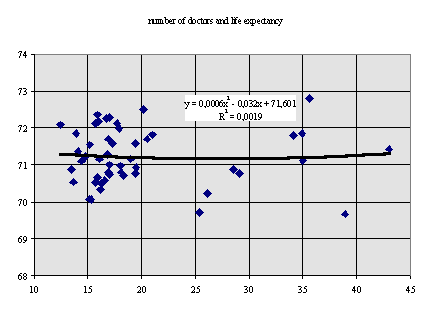
Legend and source: number of doctors per 10000 population (x-axis) and life expectancy at birth, measured in years (y-axis) for the 49 Polish voivodships. Our own calculations from regional development statistics, contained in Rocznik Statystyczny, 1996, Polish Central Statistical Office
Life expectancy is also being negatively, but not significantly, determined by foreign capital penetration. The negative trade-off, well known from cross-national policy planning and development research (Tausch and Prager, 1993), can be shown to be existing for the transformation country Poland, although the long-term negative effects of mass foreign migration on the health situation of the population in the 'guest worker export periphery' Poland are stronger than those of the direct foreign capital penetration. Here we should recall, how a guest-worker economy, in the end, can destroy the social fabric of the sender-country (see also: Chapter 10). Environmental decay is related to the general life expectancy situation in Poland, but the directly observable statistical effect is weak and below the usual significance levels, because the other intervening variables, like the social and biological stress of a guest-worker economy, are stronger. It will be expected, that especially cardiovascular-vascular diseases increase under the pressure of migration and family separation. The typical urban/rural cleavages, so well-known from policy planning and development research about the capitalist periphery (Lipton, 1977), again emerge to be relevant for the post-communist capitalist periphery. Urbanization is a positive significant determinant of life expectancy. Infant mortality rates, however, are being mainly determined by traditionalist socio-cultural patterns that express themselves in religious practice rates. Our equations explain over 70% of life expectancy and over 29% of infant mortality rates.
Again, it is being confirmed that dependent capitalism creates growth and employment only to some extent, but that its effects on the social sphere are contradictory and connected to socially long-run disintegrative tendencies. Ceteris paribus, the control of foreign capital over overall employment is even slightly negatively related to life expectancy at the voivodship regional level. Our results about Poland should also be seen in the more general context of our results about the transformation dynamic of Eastern Europe.
Up to now, the leading elites did not question the basic principles of Western integration. Political constellations might arise now, which will be more nationalistic in orientation, reflecting the peripheral role that Poland still plays in the world economy, especially when Poland should suffer a crisis like other emerging market economies suffered in 1997. Yet it would be wrong to portray the protest against the contradictions of state-class dominated, centralist, dependent capitalism, that is growing in strength in Poland over recent months, as only a backward and fundamentalist reaction against the ‘benefits of Western integration’. As Jadwiga Staniszkis has shown already for the old, 1991-1993 parliament, 100 members of parliament were at the same time members of the boards of various, state-class dominated companies (Staniszkis, 1998). By mid-1998, 17% of the assets of the 500 largest companies in Poland were in foreign hands, another 8% were in the ownership of mixed capital, the state controlled 26% directly, and another 6% via the national investment funds, while Polish private capital owned only 43%. Again and again, the Polish and the international press link some of these private entrepreneurs to shady business dealings, and their enterprise history back to the days of the communist institutions in Poland in the late 1980s. In addition, the power of illegal foreign capital inflows is enormous; Italian crime groups alone (we mentioned this already above) are estimated to launder 100000 $ an hour in Poland (see Polityka, 16, and above). A Staniszkiean picture of the Polish political landscape would look like the following: the present set-up of the centralist state, dominated by the state class, mainly recruited from the banking sector and foreign trade companies, in alliance with transnational capital, which has remained relatively stable since 1989, is challenged on various fronts, and not only by the nationalists at the URSUS tractor works and from the catholic right-wing radio station ‘Radio Maryja’:
It is thus no wonder, that according to a recent standard random-sample poll by the usually very reliable social scientific public opinion research institute CBOS, mentioned in the Polish press, only 21% of Poles consider their country today as a full democracy, while 32% see it on the way to democracy, and a staggering 35% consider Poland to be still un-democratic (Polish News Bulletin, British and American Embassy, Warsaw, 27th calendar week, 1998).
The Eastern part of Europe and the long Kondratieff wave: historical evidence
Just as during the world depression of the 1930s, democracy could not survive in the region (Polanyi, 1944), today the danger arises, that instability and not democratization will triumph in the end especially on the Balkans and in the countries of the former USSR in the long run. The turning points in the long economic waves between the ascents and decline phases (B-phases) were always the beginnings of political decay in the region as well, while the ascent phases were associated with authoritarian modernization; time-lags between the Western cycle and the Eastern semi-periphery and periphery have to be admitted (Tausch, 1997). The decisive-kairos-years are:
1509
1539
1575
1621
1689
1756
1835/42
1884
1933
1975/1982
Source: our own compilations from Goldstein and our own data interpretations after 1740, based on Goldstein. It should be recalled, that there is another tradition - based on Braudel - to view the cycle, that begins in 1689, as ending in 1747, to be followed by a 1747 - 1790 cycle, and a 1790 - 1848 cycle (for a debate about these issues, see especially Amin, 1997).
The logic of the Kondratieff waves from 1756 onwards are given as follows:
Table 9.6: The logic of the Kondratieff waves in the world economy since 1756
|
social process |
cycle 1756-1835/41 |
|
basic project |
defeudalization |
|
prosperity reform |
compulsory education, |
|
conscription; American and |
|
|
French Revolution; |
|
|
Joseph II (Austria) |
|
mid-cycle conflict |
wars of the French Revolution, |
|
Napoleonic wars |
|
|
Poland: 1807 Duchy of Warsaw |
technological change
|
basic industrial |
steam engine (end 18th century) |
|
projects |
'Spinning Jenny' (J. Stargreave, 1770) |
|
new technologies |
steam locomotive 'Puffing Billy' |
|
emerging during |
(W. Hadley, 1813) |
|
prosperity re- |
|
|
cession |
Unresolved problem freedom of association
|
crisis of the model |
revolution 1830 |
|
Poland: rebellion 1830/31 |
international regime
|
A-phase |
British naval |
|
dominance (George III) |
|
B-phase |
'congress of Vienna'-regime |
|
dominant economic |
|
|
Theory |
A. Smith, 1776 |
|
Political economy of |
|
|
world system |
D. Ricardo, 1817 |
-------------------------------------------------------------------------------------------------
|
social process |
cycle 1835/42-83 |
1884-1932 |
1933-75/81 |
|
basic project |
freedom of market |
enlargement |
welfare |
|
and enterprise |
of participa- |
state, |
|
|
|
tion |
corporatism |
|
prosperity reform |
freedom of asso- |
social secu- |
educational |
|
|
ciation |
rity, parlia- |
reform, |
||
|
mentarism |
civil |
|||
|
|
rights, |
|||
|
|
emancipation |
|||
|
|
of women |
|
mid-cycle conflict |
wars and civil |
Eastern Europe: |
Vietnam war, |
|
wars |
Revolution |
world student |
|
|
Poland: revolution |
1905 |
rebellion |
|
|
1863/64 |
1968 |
||
|
strikes, |
|||
|
terrorism |
|||
|
Polish |
|||
|
Winter 1970 |
technological change
|
basic industrial |
railway, |
steel, |
oil, |
|
inputs and |
steamship |
electricity, |
synthetics, |
|
technological |
electric |
automobile |
|
|
projects |
motor |
new technologies steel petrochemicals chips
emerging during
prosperity re-
cession
|
unresolved problem |
enlargement of participation |
relationship capital, la bour, state |
basic income environment unequal exchange |
|
crisis of the model |
Revolution |
Revolution |
Contestation |
international regime
|
A-phase |
liberal |
mercantilism |
Bretton |
|
world trade |
Woods |
|
B-phase |
-"- |
hypermercantilism |
neo-protectionism |
dominant economic
|
theory |
J. St. Mill, |
A. Marshall, |
J.M. Keynes, |
|
1848 |
1890 |
1936 |
political economy
of
|
world system |
K. Marx, 1867 |
R. Hilferding, |
K. Polanyi, |
|
|
1910 |
1944 |
The danger is of course, that the Cold-War structure will be substituted by a new power rivalry between the former members of the winning coalition of World War II:
Hegemonic wars in the world system from 1495 onwards
Table 9.7: hegemonic cycles in the world economy since 1450
|
Role in War |
Thirty Years War |
Napoleonic |
WW I+II |
|
losing hegemonic |
|||
|
contender |
Hapsburgs |
France |
Germany |
|
new hegemony |
Netherlands |
Britain |
USA |
|
|
|||
|
newly emerging |
|||
|
challenger: eco- |
|||
|
nomically deci- |
|||
|
mated member of |
|||
|
winning coalition |
France |
Germany |
China+ |
|
Russia |
|||
|
Past |
|||
|
contender for |
|||
|
systemic hegemony, |
|||
|
joining the war |
|||
|
effort of the |
|||
|
winning coalition |
Sweden |
Hapsburgs |
France |
|
Portugal |
The former hegemonic contenders slowly slide into an acceptance of their status in the international system. The real power struggle erupts already soon after the great hegemonic war, and through the ups and downs of the history of the system evolves slowly into the hegemonic challenge. Seen in such a way, not 1989, but Korea and Vietnam could become rather the benchmarks of the future W-structure of conflict in the international arena. For the foreign policies of the European Union, it is also important to notice the following tendency: German-Russian alliances tend to happen during depressions, and they break up during the economic upswings of the world system, when, especially during waning hegemonies, conflicts over spheres of influence set it (Amin, 1997, partially based on Bergesen):
Khol + Gorbi/Boris 1985 ff.
Rapallo 1922
Bismarck’s Three Emperor Alliance 1873
Holy Alliance 1815
Alliance Russia-Germany 1764
Nordic War 1700-1721
The relationship of the Kondratieff and Kuznets cycles with Russian history is the following:
Table 9.8: world economic cycles and internal instability in Russia since Iwan the Terrible
|
Reforms |
|
|
KONDRATIEFF |
Perestroika, Lenin’s NEP, |
|
OR KUZNETS |
Great Reforms 1861, |
|
DOWNSWING |
Katharinas Assembly 1775 |
|
Nobility's Victory 1730, |
|
|
Split of the State Church 1653, |
|
|
Boris Godunow 1598-1605 |
|
|
Repressive Modernization |
|
|
KONDRATIEFF |
Joseph Stalin, |
|
OR KUZNETS |
Imperialistic Expansion |
|
UPSWING |
and Repressive Industria- |
|
lization at the end of 19. th century |
|
|
Nikolas the |
|
|
Gendarme of Europe, |
|
|
Elisabeth’s expansionist |
|
|
policy, |
|
|
Peter the Great, |
|
|
Michael III, |
|
|
Iwan the Terrible |
|
Reform |
Repression |
|
|
1985 'Gorbi' |
<--------------> |
1928 Stalin |
|
57 Years |
||
|
|
||
|
64 Years |
47 Years |
|
|
1921 NEP |
<--------------> |
Alexander III |
|
40 Years |
||
|
60 Years |
56 Years |
|
|
1861 Great Reforms |
<--------------> |
Nikolas I 1825 |
|
36 Years |
||
|
86 Years |
84 Years |
|
|
1775 Constituent |
<--------------> |
Elisabeth's expansionist rule |
|
|
||
|
Assembly |
34 Years |
1741 |
|
45 Years |
52 Years |
|
|
1730 Victory of |
<--------------> |
Peter I 1689 |
|
Nobility |
41 Years |
|
|
77 Years |
76 Years |
|
|
Church Split 1653 |
<--------------> |
Michael III 1613 |
|
|
40 Years |
|
|
55 Years |
48 Years |
|
|
Boris Godunow 1598 |
<--------------> |
Iwan's 'Oprichina' 1565 |
|
33 Years |
||
|
Average periods of Russian history: |
||
|
Perestroika |
<--------------> |
authoritarian modernization |
|
40 Years |
||
|
|
||
|
64.5 Years |
60.5 Years |
Seen in such a way, there is little that the West seems to be able to do to stabilize democracy in Russia. However, the return of East Central Europe towards a ‘middle of the road’ and sensible philosophy - whatever the color of the government (Orenstein, 1996) - seems to be an urgent necessity, after the ups and downs of central planning and ‘the central market principle’.
Transformation success or failure - the macroquantitative evidence
Practically, only Poland recovered its pre-transformation real income level of 1990 (Fischer Weltalmanach, 1998: 1019). Our analysis from the world of transformation shows, that a rapid privatization is not in itself a precondition of a more rapid socio-economic development, and that a policy oriented towards human development and democracy will be successful, while extreme egalitarianism also has certain growth limits in the region (Osteuropa-Institute Munich, Working Paper 186 (GDP growth, privatization); Stiftung Entwicklung und Frieden (Political Rights Violations, based on Freedom House); UNDP, 1995 (urbanization, Human Development Index); Fischer Weltalmanach (GNP per capita)). In good Aristotelian tradition, the truth is thus - again - in the middle. The multiple regression results from the available data are given below. The first test generally supports a socio-liberal interpretation of the Matthew’s effect:
Table 9.9: The determinants of economic growth in the transformation countries
|
privatization |
Pol Rights violations |
urbanization |
ln (GNP) |
ln(GNP)^2 |
HDI |
Constant |
|
|
econ growth |
-23,53855 |
-2,007199 |
51,691191 |
-1,265286 |
-2,739098 |
0,6255463 |
-132,3854 |
|
145,43797 |
10,124597 |
139,62757 |
0,4348674 |
5,155963 |
0,346291 |
514,0504 |
|
|
0,594606 |
|||||||
|
3,666841 |
15 |
||||||
|
t-test |
-0,161846 |
-0,19825 |
0,3702076 |
-2,90959 |
-0,531249 |
1,806418 |
Note: as in all EXCEL 5.0 outprints, first rows are unstandardized regression coefficients, second rows are standard errors of the estimate, the third row shows the value for R^2 of the whole equation and the standard deviation of the estimate for y; the fourth row are the F-value and the degrees of freedom of the whole equation; the fifth row shows the sum of squares of the regression and the sum of square of the residuals. The sixth row is the t-test, calculated from row (1) and (2)
59.5% of growth in the world of transformation are explained by our equation. Thus, it emerges that the best strategy would be a policy of thorough-going reform, that assured a high human development index and a fair amount of political and civil liberties. A socio-liberal reading of recent experiences is also supported by the second analysis. The region seems to be beset by an excessive amount of egalitarianism, that becomes a stumbling block against long-run economic growth, when the share of the top income earners in total incomes falls below 35%, when taxes - compared to development level - are very high, and when the social services consume a percentage of total expenditures, that is already comparable to the most advanced welfare states in the world. The reform of social security thus becomes an all-important necessity.
The share of the richest 20% in total incomes in the region, with the notable exception of Russia, is even lower than the respective share in most developed welfare democracies, like Sweden, Finland, the Netherlands, Denmark, and Norway, or - for that matter - in the market economies of Asia. Tax rates per total income in Eastern Europe skyrocket and savings are generally low, as materials from the World Bank WDR, 1996 for the former or continuously communist countries show by international comparison. Up to a certain point, social security expenditures of the state stabilize mass demand and contribute to economic growth. High inequality rates, like in Brazil, where the top income earners received 67.5% of total incomes in 1989, are certainly growth-inhibiting as well (Tausch/Prager, 1993). But when income differentiation is below a certain limit - as in some countries of Eastern Europe and the former USSR - also negative consequences arise. The egalitarianism of movements like Solidarnosc might have its deep roots in East European history, but economically, it is counter-productive beyond a certain point. East European and transformation country inequality is positively related to economic growth, and it lowers unemployment; while transnational investment dependence brings about higher inequality and - ceteris paribus - it does not alleviate unemployment due to the capital intensity of most investments. For Eastern Europe, the choice is not the one between Latin American inequality rates (towards which Russia seems to be heading) and the former communist egalitarianism; rather the choice is the one between continuing present rates of egalitarianism (like in Belarus) at the price of stagnation or to opt for distribution and growth patterns like in the more egalitarian developing countries of East Asia before 1997. Foreign capital penetration only insignificantly contributes to the employment record, but significantly increases transformation country income inequality. Economic growth in the transformation countries is influenced significantly by two processes: political freedom and economic incentives, large enough, to overcome the vested egalitarianism of the communist years. There is little, that foreign aid will be able to do to maintain growth in the more advanced countries of the region or to shorten the transformation recession in the laggard countries of Eastern Europe. Aid dependence - beyond a certain point - rather seems to contribute to the stagnation path of the laggard countries. The internationally comparable economic and social data from the World Development Report 1996 by the World Bank make our point for the transition economies very clear. Poland, with its recent spurt of economic growth already often termed the ‘European tiger’, achieved a per-capita-income in internationally comparable $ of 5480 $. The current account balance amounted to $bn -1.1, and the trade balance -2.2, and the gross foreign debt 40.7 (GDP at 115.7). On the positive side for Poland, official development assistance amounted in 1994 to 2.0% per GNP, the highest value for all the transformation countries in Europe with complete data except Albania. But the 27% of population, who live from agriculture, just receive 6% of the total GNP - an expression of the perennial structural heterogeneity of Polish society, that characterizes the country from the Long 16th Century onwards. The empirical cross-national evidence is presented below:
equation (9.3) economic growth =
|
Gini inequality |
political repr . |
civil rights |
ln (GNP) |
(ln(GNP))^2 |
constant |
|||||
|
|
violations |
|||||||||
|
10,91358546 |
-162,8188826 |
-0,722897795 |
0,116576987 |
-11,0941545 |
607,4708743 |
|||||
|
2,711016139 |
39,90219401 |
0,98220757 |
0,764921232 |
10,11245772 |
148,4162944 |
|||||
|
0,6951136 |
||||||||||
|
4,103838325 |
9 |
|||||||||
|
4,025643853 |
-4,080449376 |
-0,735992897 |
0,152403911 |
-1,097077962 |
t-test |
|||||
equation (9.4) GINI income inequality =
|
pol rights violations |
civil rights violations |
FCAPPen |
lnGNPpc |
lnGNP^2 |
constant |
|
-0,018992718 |
0,176971676 |
0,004611249 |
-0,020469912 |
0,006726173 |
0,061751233 |
|
0,025122747 |
0,324494352 |
0,002916141 |
0,028052902 |
0,020223575 |
1,016901378 |
|
0,504766872 |
|||||
|
2,24235225 |
11 |
||||
|
-0,755996872 |
0,545376754 |
1,581284635 |
-0,729689648 |
0,332590687 |
|
|
pol rights violations |
civil rights violations |
FCAPPen |
lnGNPpc |
lnGNP^2 |
equation (9.4) unemployment rate =
|
GINI inequality |
pol rights violations |
civil rights violations |
GNP per capita |
FCAPPen |
constant |
|
-0,218971053 |
0,000392913 |
-1,528791364 |
-0,907559915 |
-17,56078807 |
19,53812103 |
|
0,183471851 |
0,000686046 |
2,166180602 |
1,418759587 |
14,50565314 |
6,935047266 |
|
0,56989396 |
|||||
|
2,385014466 |
9 |
||||
|
-1,193485827 |
0,572720543 |
-0,705754341 |
-0,639685485 |
-1,210616847 |
T-test |
|
GINI inequality |
pol rights violations |
civil rights violations |
GNP per capita |
FCAPPen |
Source: our own calculations with EXCEL 5.0 multiple regression routine from the above mentioned data. As in all EXCEL 5.0 outprints in this work, first row: unstandardized regression coefficients, second row: standard errors, last row: t-Test. The values immediately below the standard errors are R^2 (third row, left side entry), F, and degrees of freedom (fourth row).
Eastern Europe cannot be ‘saved’ by external means or by external means alone. The mobilization of savings and exports, a clear-cut policy of human capital formation and technology, and various other reforms would achieve much more lasting effects than transfers - even on a scale like in East Germany (estimated at $bn 700 since 1990).
The World Bank has developed a liberalization index, which measures the extent to which policies supporting liberalized markets and entry of new firms prevailed. The index is a weighted average of estimates of liberalization of domestic transactions (price liberalization and abolition of state trading monopolies), external transactions (elimination of export controls and taxes, substitution of low to moderate import duties for import quotas and high tariffs, current account convertibility), and the entry of new firms (World Bank, WDR, 1996). The weights on these components are 0.3, 0.3, and 0.4, respectively. Our equation now summarizes our final research results about the transformation success/failure in Eastern Europe and the former USSR:
equation (9.6) economic recovery in Eastern Europe and the former USSR:
|
privatization |
Pol Rights Violations |
ln (GNP) |
ln(GNP)^2 |
HDI |
NET FLOWS |
DEV ASS |
Liberalization |
Constant |
|
0,536737 |
-6,757594 |
-0,988263 |
-4,253716 |
18,634372 |
-274,6279 |
4,6616276 |
0,932771 |
1024,9646 |
|
5,2836872 |
2,9991756 |
1,9402744 |
167,95219 |
13,84864 |
197,52304 |
5,844472 |
0,6182559 |
727,345 |
|
0,5709663 |
||||||||
|
2,1625809 |
13 |
|||||||
|
privatization |
Pol Rights Violations |
ln (GNP) |
ln(GNP)^2 |
HDI |
NET FLOWS |
DEV ASS |
Liberalization |
|
|
0,1015838 |
-2,253151 |
-0,509342 |
-0,025327 |
1,3455741 |
-1,390359 |
0,7976131 |
1,5087134 |
|
Source: our calculations from the above Tables on the basis of the EXCEL 5.0 multiple regression program. As in all EXCEL 5.0 outprints in this work, first row: unstandardized regression coefficients, second row: standard errors, last row: t-Test. The values immediately below the standard errors are R^2 (third row, left side entry), F, and degrees of freedom (fourth row).
The indicators, which affect transformation in a significant and positive direction (at 10% error probability) are liberalization and the freedom from political repression. Foreign aid is only marginally efficient in promoting growth, while a policy of human development has a positive effect on growth, and net inflows - ceteris paribus - even a negative effect. Thus it has been established again, how important it is for the transformation countries to carry on with political transformation and reform. Without political pluralism, economic transformation will definitely fail. Our results, by and large, confirm the conventional UNDP wisdom on the transformation process, already expressed in the UNDP 1992 and 1993 Human Development Report. Confronted with the ‘market frenzy’ of the early transformation years, our results do not explicitly contradict, but they do correct much of the conventional neo-classical wisdom prevailing at that time. Recently, Finance Minister Balcerowicz spoke about his plans to reduce the state sector in Poland to just 10% of the national product - but even in one of the remaining market economy ‘superstars’ Chile we have a central government share of 21%, and only in some developing countries, like Guatemala and Myanmar, we reach such proportions. In the USA, the central government share was 23% in 1994, to which we have to add the often powerful economic influence of the other federalist entities.
Measures aimed at maintaining and building up democracy and human development are just as important as the fight against local monopolies, expressed in the liberalization index. Privatization, external development assistance and capital inflows, under due consideration of these factors, are not so important as these, more immediate goals, which find their ultimate aim, above all, in the rule of law.
Our analysis of the trajectory of the transformation countries should be concluded by an assessment of the realistic possibilities for EU-eastward expansion. On the one hand, Western Europe should avoid illusions about its own weak position in the world economy. Germany’s tragedy always seems to be a ‘sandwich’ position between the dominant centers of maritime capitalist accumulation and the temptation to squeeze the East European ‘hinterland’ in order to be able to challenge the world hegemonic leaders (Arrighi, 1995). Wait a moment: this is not anti-German talk by an Austrian, but a sincere preoccupation about the future political economy of that former European work bench, that now occupies only rank 19 of the world-wide human development index scale, whose unemployment rate reaches 5 million people, the worst figure since the days of Weimar, and that has 12% of its people living with less than 14.40 $ a day (UNDP, 1997). After the integration experiment of the new Laender, that under Kohl’s 1:1 exchange conditions ruined eastern exports and cost DEM bn 150 to 200 a year, Germany continues to pay up to 70% of the European Union entire budget and will risk to pay another DEM bn 150 to 200 a year for European Monetary Union (Watzal, 1997). Germany’s current account balance after German unification, and even more so after European Monetary Union, could and can only increase at the expense of the East European current account balance - a potential of economic nationalism and conflict in the new European house after 1989. The sharp world political conflict over spheres of influence in Eastern Europe between Germany and Russia, that is predicted by world system theories during each world economic upswing, threatens to become a reality again under such circumstances. And that is the situation, with which we are already presented: Germany comes out from its current account deficit, while America’s balance deteriorates further and Japan will recover. A trilateral split of the world economy into three major currency blocks will be the most likely outcome under such circumstances:
Graph 9.7a: current account balances in the capitalist world economy, 1991-98 in % of GDPs
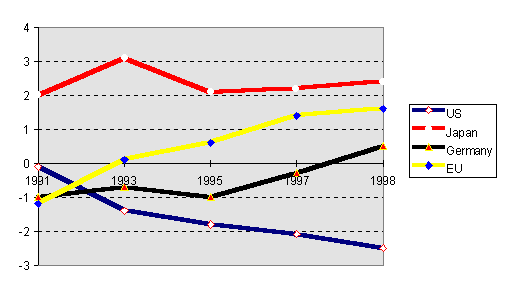
Legend: current account balances in % of the GDP since 1991. Our own compilation from Le Monde (1998), ‘Le Bilan du Monde’ Paris: Le Monde
Secondly, the environmental strains, already existing in the Union, will increase. But thirdly, and above all, eastward expansion of the Union will be first and foremost a test of Europe’s ability to stand by its commitment towards democracy on the European continent. A small number of nations - in terms of the current account balance - are becoming again the winners of the international system, while a great number of other nations (in our map in lighter shades) are the losers of international exchange. Our map summarizes the tendencies of the current account balance in the world system:
Map 9.1: current account balance in the world system
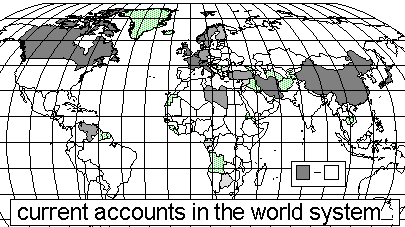
Source: our own compilations from Fischer Weltalmanach, 1997 and EXCEL 7.0 maps. The darker, the higher the positive current account balance.
A well-designed policy of Eastern European integration into the Union, that stresses the elements of democracy, savings mobilization, liquidation of local monopolies (also for the sake of the environment!) and early market access for the East Europeans in the agricultural sectors, could be successful; however, this policy would imply, that the European center itself adapts rapidly to the contemporary challenges. Eastern Europe’s case during the negotiations with Brussels will be, that at present, its overall social performance is not worse than that of the European Union periphery. Poland, the Czech Republic and Slovenia have still a relatively favorable growth record, and the democracy scores in 1993 were as good as those in Italy and Greece. The question is, however, how many more European peripheries the ‘real existing Union’ can reasonably afford. Considering the negative current account balance tendencies and the pressure that they exert in the direction of a ‘weak state’, I think it is most likely that the negative part of the Barta and Richter-scenario (1996) about the integration process of the East European new democracies into the European Union will come true:
On the other hand, the internal European Union development blocks (see below) create a situation, were Union enlargement brings one of the few dynamizing effects for the Union itself. Whether or not Poland and the other accession countries will be able to follow the more dynamic paths of Ireland or Spain, which today has a higher human development index than Germany or Austria, is of course open to question. But social scientific experience tells us that Poland will become rather a sort of Greece in the enlarged Union, with long-term slow growth, high unemployment, a large negative current account, a high dependence from labor migration, and high debt ratios.
Europe must come to terms with the contradictions of the process of the aging of democracies, especially phenomena which one might term sclerosis bruxelliana and sclerosis Europea
There is a growing awareness in labor-oriented and ‘social movement’ circles around the world that state expenditures are, more often than not, directed towards the rich and even the crooks benefit from them by subvention and customs fraud, while the poor are marginalized. Neo-liberal theory created the concept of distribution coalitions: people, who by political pressure or worse cut out their slice from the market which otherwise would not have been as big. Just to name a few figures from the current international press: the shadow economy now comprises up to 45% of Polish GNP; and fraud and other criminal practices determine that up to 5% of the EU yearly budget end up in the pockets of gangsters. Distribution coalitions block, while new market opportunities dynamize the social system of the European Union. The message of this Chapter is thus simple: the European Union has very powerful internal distribution coalitions at work, that make its whole policy-set up non-competitive in the world economy (see, amongst others, Nollert, 1997; Nollert and Fiedler, 1996; as to the argument about European law and democracy by two Austrian diplomats, Thun-Hohenstein and Cede, 1996; also, from an Austrian Green perspective, Voggenhuber, 1995). Without enlargement, the Union is doomed even more to stagnation. Enlargement is a great opportunity and chance to realize a socio-liberal model on a European scale. Without question, the future of the European project of integration is of vital importance for the perspectives of the forces of change in the other regions of the world economy (Amin, 1997). With the dominating Wall Street counter-project of financial and economic globalization in full swing, the European project - that could start out from a still significant share of global economic resources - is seen by many as the only and last realistic chance to transform the world economy. The race to the bottom, US-style, will never be the perspective of European Labor. But suppose, the eurocrats with their strange mixture of monetarist dogma and interventionist expenditures for narrow distribution coalitions and consultants were right, what would follow from this? Clearly, if the Union were to be an instrument of world economic ascent and growth (as the euro-crats would have us believe, for - why else - should we have the Union at all), then the countries most integrated into the system should be the real tigers of the world. The very geographical center of the Union, Belgium (then a haven of growth, political and social development and freedom from scandals and corruption), with the Union capital Brussels, would have to be on an equal footing with Hong Kong before 1997, and the founding member nations, like Germany, France and Italy, should have unemployment rates well below the outsiders, like Japan, Switzerland, Iceland, Malta, or Norway. But average EU unemployment stood at 11.1% by 1995 (UNDP, 1997: 210), while outsiders as different from each other as the USA, Canada, Japan, Australia, Norway, Iceland, New Zealand, Switzerland, Malta, and even the transformation countries Czech Republic, Latvia, Lithuania and Estonia, were all below, sometimes significantly below this average unemployment rate. Looking at the figures of unemployment in the 1980s and 1990s of the European Union and the OECD countries, one has to arrive at the depressing conclusion that unemployment in the OECD region now stands at 7.6%, while in the EU it reaches 10.9% (Le Monde, 1998).
The harsh critique by the growing number of eurosceptics among professional social scientists now precisely is, that the Union, as it is structured, is not the answer to the problems, but the very reason for them. Wait a moment, you might say: is that really so? What is that correlation between unemployment and European Union membership on the level of the industrialized countries? The data-base is UNDP, 1997 and Federal Ministry of Labor, Health and Social Affairs of the Republic of Austria:
|
Country |
unemployment |
membership in EU/yes/no |
|
CND |
9,5 |
0 |
|
F |
11,6 |
1 |
|
N |
4,9 |
0 |
|
USA |
5,5 |
0 |
|
NL |
6,5 |
1 |
|
JAP |
3,1 |
0 |
|
SF |
17,1 |
1 |
|
NZ |
6,3 |
0 |
|
SW |
9,2 |
1 |
|
SP |
22,7 |
1 |
|
BL |
9,5 |
1 |
|
AUS |
8,5 |
0 |
|
UK |
8,7 |
1 |
|
CH |
4,2 |
0 |
|
AUT |
4,5 |
1 |
|
DK |
10,1 |
1 |
|
GR |
9,8 |
1 |
|
LUX |
2,8 |
1 |
|
IRE |
12,9 |
1 |
|
GER |
9,3 |
1 |
|
ITA |
12,2 |
1 |
|
POR |
7,1 |
1 |
The correlation between unemployment (1) and the dummy variable Union membership (2) is +0.44; the R^2 is above a depressing 19%. That is dramatic enough. The political right in Europe, especially in German-speaking countries, has reacted to the growing (socio)liberal and left critique of the essence of the Union by disbelief and even recurrence to old slogans like ‘Volksgemeinschaft’ while sectors of the political left reacted and reacts in an almost fundamentalist way by denouncing growth itself, castigating it as Wachstumswahn and Wachstumsfetischismus.
We move to the very center of the EU debate in its present form - is the Union an engine of capitalist ascent? The political project of transformation from communism in Europe is not only endangered by the contradictions, globalization creates in its host countries, it is also threatened by certain negative developments in the European 'anchor economy'. Almost all the big issues, like agriculture reform, institution reform, structural funds, let alone a real strengthening of the Third Pillar against transnational crime, more rights for the European Parliament, a real common foreign policy, reform of the institutions of the EU, are blocked, and there seems no way out. And the real existing Union, with all its deficits, and without a profound reform, won’t be able to absorb a 15 + 5 + 1 membership, let alone millions of extra agricultural producers.
We concentrate here on these issues, which have a long-term strategic and theoretical relevance for the policy formulation in the new Europe. In order to provide a valid strategy to its member countries, the Union has to be an association of world economic ascent and not a club for joint world economic decline. Very early on, a group of European policy planning and development researchers, headed by the late Dudley Seers, challenged head-on the reigning visions of the development strategy of the Commission in Brussels towards the Third World and towards the European periphery (Seers, 1978; de Bandt et al., 1980). This theoretical challenge, still worthwhile reading today, was the first real and systematic question mark behind the policies of the Commission since 1958. The authors of that critique were a European-wide group of committed students of development and committed Europeans at the same time. Its leader, Dudley Seers, as one of the doyen of development and distribution theory among the world-wide profession of economists, having influenced the course of Keynesian economics over the whole post-war years in Britain, and above all a passionate Scotsman, took up the issue of the center-periphery relationship that characterizes the South, Northwest and eastbound relationship of the Union (Seers, 1978). Several authors, most notably Inotai and Malcolm, developed these arguments from a later, liberal perspective. With its emphasis on structural protection, Inotai maintains, the Union increases rather than decreases the long-term cleavages between the centers and the peripheries inside and outside the boundaries of Europe. Today, it is no secret, that 90% of all EU expenditure, union-wide, must be categorized as subventions. With each expansion to semi-peripheral regions, the protective element increases. Simple, as the diagnosis might sound, it strikes at the very heart of the conventional Union wisdom on matters of external economic relations. A good part of professional economists the world over, liberal and radical social scientists alike, have later taken up this theme. They maintain that the Union, by its market protecting arrangements with the outer rim of its orbit of influence leads to a secular negative balance of trade of the periphery regions with the Union, and thus prolongs structural underdevelopment (amongst others such divergent authors as Hickman, 1994; Inotai, 1993; Kennedy, 1993; Amin, 1994). The arguments of such Union critics cannot be dismissed a-priori and out of hand. Western Europe lost in terms of world market shares in a secular trend vis-à-vis the countries of the Pacific; the dynamics of growth in the world economy seemed to work to the detriment of the old European centers. Le crash, 1997 - we still have to wait and see. Asia’s ‘basics’ are healthier than expected, and the tide might still turn to the detriment of the Europeans, especially when in summer 1998 there could be a speculative crash in Europe, for example against the Lira or the Zloty, against the very US $, or perhaps against the EURO, after 2004 or 2005, when the initial positive effects of European Monetary Union fade away and transnational capital flows again to the Pacific region.
The European Union shortcomings vis-à-vis the Pacific in terms of world export markets for manufactured goods, in terms of comparative labor costs, in terms of technological and scientific development and in terms of employment are all too obvious and were described in the literature in all detail, the crash of 1997 notwithstanding (for a debate on these issues see Inotai, 1993; Kennedy, 1993; Tausch and Prager, 1993, IFRI 1998). I strongly agree with Andre Gunder Frank’s statements on the University of Colorado’s ‘world system network’ via the Internet: it is the first time in world economic history, that an economic crisis began in a center outside Europe or the United States. The fundamentals of the European Union still reflect the realities of the late 1950s and still comprise the following sectors (i) the coal and steel community (ii) agricultural self-sufficiency (iii) the customs union. The new international division of labor, that characterizes the world economy since the late 1960s, is the prime challenge to the logic of the Union, built around and evolving from the Franco-German alliance of the late 1950s (Inotai, 1993). Precisely these sectors are most seriously affected by world economic and technological changes. The annual cost of the common agricultural policy of the Union is now estimated to be $ 45 thousand million, more than 10% of this is believed to be paid to criminal channels (Malcolm, 1995: 57). It dominates the Union's external trade policy, distorting the world market and preventing the poor countries from exporting.
A major problem, which has to resolved first and foremost, is Germany's apparent inability to comprehend and play its role as a highly developed Mexico in the world economy. Similar in population size to that of Mexico, and with a share of roughly only 8% of world GNP, Germany's first and foremost role would be that of a highly specialized trade and current account surplus economy in the heart of a Europe, oriented towards the West and towards the Atlantic and the Pacific, still the major centers of the world economy. Germany is estimated - via its share of Brussels expenditures - to have spent up to $bn 30 thousand million alone to prop up in vain - in concert with the other Europeans - the Italian Lira on Black Friday, 1993. In that disaster year, Germany poured another 9.1 thousand million $ down another sink - this time German aid to Russia. Insiders estimate, that only 10% of Western aid to Russia reached its targets. How Germany projected in vain her dreams to become a democratic 'Weltmacht' (world power) is to be judged from the fact, that it took over 43.7% of the burden of reconstruction of former communism - from Frankfurt at the Oder to Wladiwostock during the period 1990-1993. If Lohengrin only were to be an economist, after all: Germany's official and private Eastern flows amounted to 32.7 thousand million $, out of a total of 74.8 thousand million $ (our own compilations from OECD, GD (95) 41: 'Aid and other resource flows to the Central and Eastern European countries and the new independent states of the former Soviet Union in 1992 and 1993', Paris 1995). But the foundations of Germany's dreams to become a Weltmacht were shaky indeed, as the meager position of Germany's transnational corporations vis-à-vis their international competitors, and the losses of even companies like Mercedes-Daimler-Benz to the tune of more than 1 thousand million $ and the economic malaise in the middle of 1990s all too clearly showed. Only of lately, German transnationals could recover some of their positions (Le Monde, 1998). Add to this the recent disaster of the new Mercedes car, developed at great costs, but practically knocked off from the market by a single test series of an automobile magazine in Sweden. $bn 700 for German unification, DEMbn 160 for Russia’s pullout from East Germany - enough is enough. For the transformation countries nearer to the European center, such economic mismanagement means lost opportunities to stabilize democracy at a vital moment of world history: the Polish GNP amounted to just 75 thousand million $ in 1992 and is today $bn 135.8 (UNDP, 1995; Malcolm, 1995; Business Central Europe, May 1998), viz. about double the sum that Germany lost in the casino of world finances in 1993. Germany with its current account balance of $bn -18.5 in 1996, $bn -5.5 in 1997 and Sbn +10.0 in 1998 is in a too weak position to be the European ‘growth engine’ anymore:
Graph 9.7b: current account balances in the world system, 1996/97, in millions of $
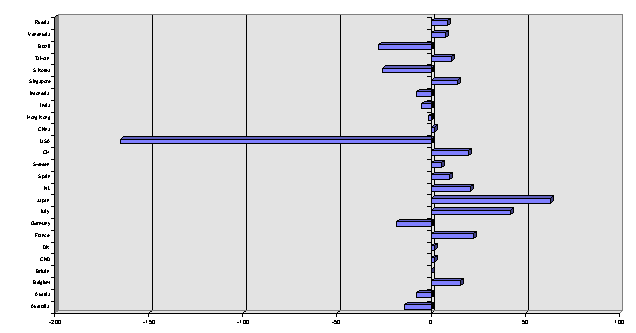
Legend: current account balances in the world system, 1996/97, in millions of $; compiled from the international press
Graph 9.7c: the structure of world trade (in % of total world trade; for the ‘triad’ of Asia, North America, and Europe: percentage of regional per total trade of the ‘triad’ countries)
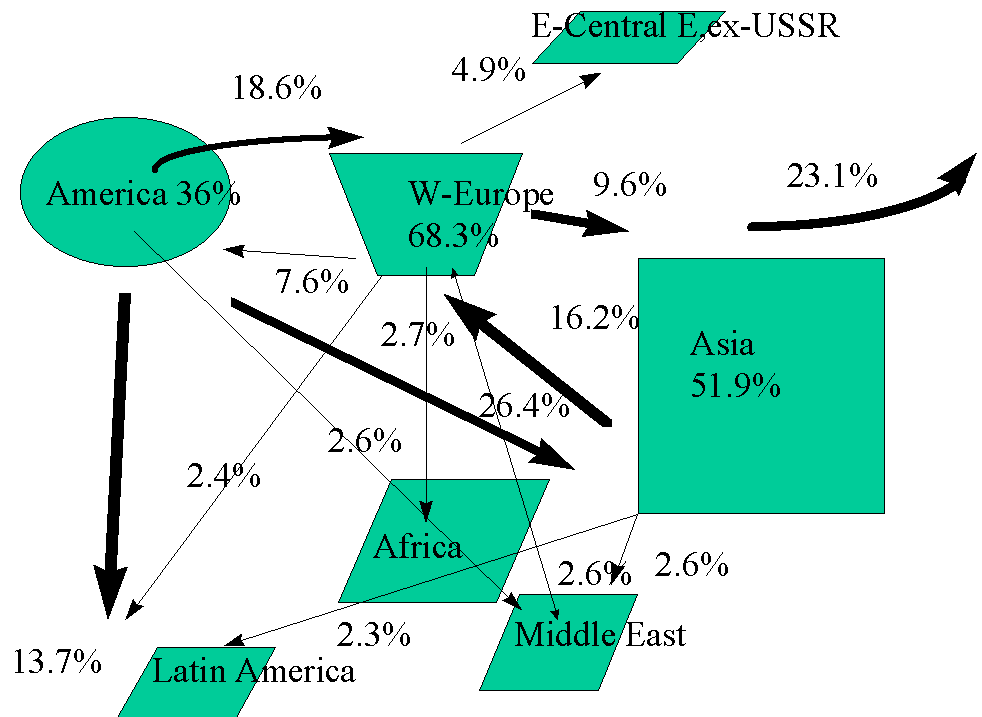
Legend: intra-triad trade in percent of total triad trade and international trade in % of total world trade. Sources for the above graphs: current Account Balances, 1997. Compiled from Economist, June 7th - 13th 1997, and world trade statistics in Le Monde, 1998: Le Bilan du Monde. Paris: Le Monde
Several authors, including Chase-Dunn and Hall, are fairly pessimistic in this context about the future trajectory of the United States of America. They cite international capital investment abroad in those countries, where profit rates are highest, as the main reason, why the ‘internationalized capitalists’ in the core no longer have a vested interest in their home economy. Capital investment abroad becomes, the argument goes, the driving force for hegemonic decline (Chase-Dunn and Hall, 1997). America’s current account balance as a percentage of GDP performed in the following way over the years:
|
1961-73 |
+0.4% |
|
1974-80 |
+0.0% |
|
1981-90 |
-2.0% |
|
1993 |
-1.5% |
|
1994 |
-2.2% |
|
1995 |
-2.0% |
|
1996 |
-2.2% |
|
1997 |
-2.3% |
|
1998 |
-2.4% |
Source: IFRI, 1998
The hegemonic decline of the USA will most probably set in slowly, cushioned by the present weaknesses of Japan and of the European competitors. In Europe, economic stagnation and unemployment will significantly rise due to rent-seeking that is enhanced by the way European institutions are built at the present. In terms of the environment, government subventions to declining productive branches will increase technological backwardness and preserve transport intensity, and hence, pollution. Economic inequalities threaten to increase with such a structure, and in turn will form a block of its own against world economic ascent. The expenditure for research and development in the Union budget 1994 was just 3.6%; general and professional education received only 0.8% of the total Union expenditures; the energy sector, EURATOM and the environment another meager 0.2%; while expenditure for agricultural subventions consumes 53.5%, and structural policies for regions, for (big) agriculture, traffic systems and fisheries another 30.7% of the total budget (our own compilations from Fischer Weltalmanach, 1995). Not only the internal set-up needs urgent reform, also the relationship to the outside world.
Inexorably, the centers of gravity of the world economy are shifting towards the LDCs, here most notably during the 1970s and 1980s to the countries of the Pacific, and after the Asian currency crisis 1997, most likely to India and China. The effect of the Europe-agreements between the EU and the countries of Eastern Europe seem to repeat the experience of Lomé and can be summarized in one word: a massive positive balance of trade in favor of the Union and to the detriment of the partners in the East, that leads to political and economic friction (Hickman, 1994; Inotai, 1993). A growing number of academic critics of present Union economic policy maintain that the EU-approach to foreign trade and relations with the semi-periphery and the periphery is based on two fatally erroneous assumptions. First, the gradualism of trade liberalization; second, the protectionist answer to the current economic malaise in Western Europe.
Samir Amin (1994, 1997) puts a heavy blame on the Europeans for prolonging the underdevelopment and stagnation of their own ‘backyards’. The experience of East and Southeast Asia during its heyday has precisely shown, that ceteris paribus three conditions for successful capitalist development hold (i) the existence of a reliable anchor economy (ii) substantial net transfers (iii) free market access to exports (Inotai, 1993). The failure to realize such a strategy vis-à-vis the CEFTA-countries results in the growing trade balance problems of the transformation region (Hickman, 1994). By enlarging the Union to the South, the protective tendencies precisely in those sectors, which are also important for the semi-periphery and the periphery, have grown. The effect of this was a growing world economic inefficiency (Nuscheler, 1993). The most visible result of this is the high unemployment in many Union countries (almost 17 million people in 1995; UNDP, 1997, at the beginning of 1998, more than 18 million people); in the Eastern European countries most likely still to join the Union early on, another 3.7 million unemployed persons would have to be provided with jobs. The new Union members Austria, Finland and Sweden, which joined the Union on January 1st 1995, are not free from employment problems themselves and had a stock of 992000 unemployed persons of their own, that is to say, almost another million, within their own borders by 1995 (UNDP, 1997). Most notably, unemployment in Finland is very high and reached 18.2% (Fischer Weltalmanach, 1998). To put the proportions of unemployment in even more drastic words: the unemployed workers of the EU - excluding their families - would already be the 6th biggest state in the Union - bigger than each of the 10 smaller European Union countries. The up to 40 million persons, affected by unemployment (i.e. the unemployed and their families), probably would form the 5th biggest state in Western Europe, only surpassed in size by Germany, the UK, France, and Italy. With around 40 million inhabitants like Spain, this 'country' should play a major role in the EU and should one day be in a position to take up at least the EU-Presidency...
Globalization affected to a differing degree the 21 most developed and still relatively stable long-term democracies of the world, Australia, Austria, Belgium, Canada, Denmark, Finland, France, Germany, Iceland, Ireland, Israel, Italy, Japan, Luxembourg, New Zealand, Norway, Sweden, Switzerland, the Netherlands, the UK, and the United States of America. Of course, the term 'stable democracy' is only relative. In future, the increase of new populist or neo-fascist parties in Europe will become an even more significant phenomenon, while old parties disappear. On average, populists drum up 7.4% of West European votes; neo-fascists 2.2%. Countries with well-known populist phenomena are Austria (23%), Denmark (16%), Italy (21%) and Norway and France (both at 12%), while neo-fascists are strongest in Italy (14%) (Taggart, 1995: 45). Regionalism and other centrifugal tendencies will increase in other parts of the continent.
The (in)efficiency of the European Union at the level of stable western democracies
Nollert (1996) has shown that the efficiency of an interest group at the Union level is largely determined by the age of an interest group, by the relative efficiency of internal decision making mechanism, by the low number of members, restricted to Union countries, and by the ‘Unionization’ of the central policy concern of the respective interest group. The basic democracy deficit of the Union, that is evident in the powerlessness of the European Parliament, actively enhances the power of these narrow distribution coalitions. Among the most powerful ones, the European Roundtable of Industrialists emerged, closely linked to Etienne Davignon, the long-term EU Commissioner for the Internal Market, linked to key Western capital groups like Rockefeller, Standard Oil, Asea-Brown-Bovery, Deutsche Bank, Fiat, Volvo, Renault, Societé General, Unilever, and later on also to the Trilateral Commission (Nollert and Fielder, 1997). The case of the Roundtable shows, that European capital integration is far more advanced than that of its countervailing power, organized labor. Johannes Voggenhuber, an Austrian member of the European Parliament for the Green Party, and an impassioned - if perhaps not always error-free critic of the ‘real existing Union’ - , has summarized the development blocks that the Union faces as follows:
‘The law-makers of the European Union are organs of the Executive. Laws are being passed in the Council, that is to say, by Government representatives of member states. Exclusively the Commission holds the right for law-initiatives, which is a non-elected (...) administrative body. Its suggestions can be altered by the Council only unanimously. Even that, the Commission can prevent this, by simply withdrawing its proposal (...) Laws are deliberated and passed under the exclusion of the public (...) Two Hundred Years after the French Revolution, laws again go into effect in Europe, which were not passed by an elected, lawmaking assembly’ (Voggenhuber, 1995, our translation)
The very center-piece of the European Union is its agricultural policy, which, throughout the ups and downs of European integration, swallowed more than 50% of its budget. 6% of grain producers produce 60% of Union grain; 15% of milk-producing entities produce more than 50% of total production. 10% of cattle breeders possess 50% of all cattle in the Union. 20% of producing units receive 80% of all subventions.
Such a monopolistic system, Voggenhuber correctly argues, has its heavy economic price: stagnation. 50 million poor people, three million homeless, millions of unemployed, a threatening and recurring tendency towards a growing gap between the rich and the poor regions. Over the last years, there has been a certain shift in real wealth from the North to the South, aided by a policy of soft currencies in countries like Italy or Spain, thus counterbalancing the inherent internal tendencies of the Union. One of the main arguments for the EURO was that it will rule out once and for all such a world economic adjustment; the wage rate, or worse, if that is inflexible, the unemployment rate or migration will be the only adjustment mechanism left open for the European mezzogiorno after introduction of the Euro.
We now start our multivariate analysis of the basic problems of the European Union (as to the variables used, see Appendix, Variable list). The basic equation can be expanded in the following fashion:
equation (9.7) stagnation and development blocks in western democracies (lack of economic growth; inflation; lack of human development; unemployment) = constant + b1 * age of democracy + b2 * state sector influence (like state sector expenditures per GDP), tn-1 (+ b3 * years of European Union membership (like state sector expenditures per GDP))
The original data for a repetition of Weede’s original exercise (i.e. the terms age of democracy and state sector strength), based on stable world politically guaranteed boundaries, were:
equation (9.8)
|
Sweden |
48 |
28 |
1,7 |
|
Israel |
17 |
44 |
1,7 |
|
USA |
61 |
19 |
1,7 |
|
Finland |
48 |
24 |
2,5 |
|
Belgium |
20 |
39 |
2 |
|
Denmark |
20 |
33 |
2,2 |
|
Ireland |
42 |
33 |
3,3 |
|
Austria |
10 |
30 |
2,1 |
|
New Zealand |
86 |
31 |
0,7 |
|
Norway |
20 |
35 |
2,3 |
|
Australia |
73 |
20 |
1,6 |
|
Italy |
20 |
30 |
2,2 |
|
United Kingdom |
47 |
32 |
2,6 |
|
Germany |
16 |
24 |
2,2 |
|
Netherlands |
20 |
41 |
1,6 |
|
Switzerland |
93 |
13 |
1,6 |
|
Canada |
67 |
20 |
2 |
|
Japan |
13 |
13 |
3,6 |
|
France |
20 |
32 |
1,8 |
|
Iceland |
17 |
44 |
1,7 |
|
Luxembourg |
20 |
41,3 |
3,5 |
|
age of democracy by 19 65 |
central state sector strength 1972 |
economic growth 1980-1991 |
equation 9.8 (cont.) economic stagnation as a consequence of the interaction between a strong state sector and an aging democracy
|
age of democracy 1965 |
central state sector strength 1972 |
constant |
|
|
basic equation |
-0,029841372 |
-0,017474418 |
3,661178511 |
|
economic growth |
0,017359935 |
0,006306644 |
|
|
0,300811182 |
|||
|
3,872059412 |
18 |
||
|
-1,7189795 |
-2,770794915 |
T-Test |
Legend: as in all EXCEL 5.0 outprints in this work, first row: unstandardized regression coefficients, second row: standard errors, last row: t-Test. The values immediately below the standard errors are R^2 (third row, left side entry), F, and degrees of freedom (fourth row).
Economic growth is blocked by the interaction between a strong state and growing democratic age: the European predicament, all the European attempts at advances in the field of human development, sustainable agriculture, environmental protection, and gender empowerment notwithstanding.
The empirical results now show the effects of years of European membership on growth with relatively new data, relating state sector expenditures not to the preceding, but to the current measurement period of economic growth. Results, which are significant at the level of 10%, are printed in indented type, and results, significant at the 5% level, are printed in bold type . Some of the reform needs of the Union are omnipresent. The longer you stay inside, the more rent-seeking, and stagnant your economy and society could become in comparison to the other Western democracies. Human development is influenced in a negative, but not significant fashion by membership years, while inflation - as part of the still existing ‘social partnership’ in Europe - is somewhat lower than in other OECD democracies. Old democracies tend to have lower inflation rates, while a high state sector influence increases inflation rates:
equation (9.9) 21 stable OECD democracies (before the Union enlargements 1981, 1986, 1995)
|
age of democracy 1980 |
state sector strength |
years of membership in the European Union (93) |
constant |
|
|
growth 80-91 |
0,005957107 |
-0,031878483 |
-0,016183125 |
3,840249096 |
|
0,00999156 |
0,018006481 |
0,006778025 |
0,78650603 |
|
|
0,315131817 |
||||
|
2,607431627 |
17 |
|||
|
0,596213893 |
-1,770389437 |
-2,387587165 |
||
|
Human Development Index 1992 |
-0,000122587 |
-0,000610284 |
-3,87854E-05 |
0,938652952 |
|
0,000181832 |
0,000327691 |
0,00012335 |
0,014313245 |
|
|
0,259690135 |
||||
|
1,987785794 |
17 |
|||
|
-0,674180237 |
-1,862375606 |
-0,314433415 |
||
|
inflation 1980-91 |
-0,620613252 |
1,213851255 |
-0,069484856 |
-14,2296436 |
|
0,253153083 |
0,456224654 |
0,171732728 |
19,92746094 |
|
|
0,412664429 |
||||
|
3,981423697 |
17 |
|||
|
-2,451533457 |
2,660643708 |
-0,404610449 |
||
Legend: as in all EXCEL 5.0 outprints in this work, first row: unstandardized regression coefficients, second row: standard errors, last row: t-Test. The values immediately below the standard errors are R^2 (third row, left side entry), F, and degrees of freedom (fourth row).
Variables:
democratic age within stable world political boundaries by 1980 (Source: Weede; Tausch, 1993a)
central government expenditures 1972 (Source: World Bank, 1990, Fischer Weltalmanach, current issues)
years of Union membership by 1993 (Die Presse, 1. 11. 1993)
economic growth (GNP per cap.) 1980-91 (UNDP, 1994)
human development index (UNDP, 1994)
yearly rate of inflation, 1980-91
Our following analysis is a scenario for the effects of EU-enlargement. Several newly stabilized democracies, like Greece (1981) Spain and Portugal (1986) have entered the European arena, and processes ever since their democratic transformation suggest that these countries must be considered as stable as the ‘old’ core of the European Union. In addition, Germany’s globally recognized borders have shifted after the fall of the Berlin Wall, thus suggesting that we have to consider Germany in the new borders as a relatively young democracy, that leaves behind many of the characteristics of the old Federal Republic.
Our enlargement scenario now shows, that - under proper control for the effects of the ‘socio-liberal’ policy variable ‘human development index’, - the negative significant growth effects of Union membership years disappear, and although the negative direction of the effects on growth does not disappear, the Union contributes positively towards stabilizing inflation and towards decreasing the level of absolute poverty. The positive development experience of countries like Spain, Portugal and Ireland after Union integration must be mentioned here. Significant transfers, intensified trade and economic restructuring, along with a well-designed policy of economic management and human development in these three nations, have flattened the European North-South divide considerably, while Greece’s record must be regarded as rather mixed.
Economic growth and employment creation continue to be the darker, negative sides of the present European constellation. The 10% significant stagnation effects against growth and pro higher unemployment by the state sector expenditures and by the years of Union membership must give pause for thought in Brussels:
equation (9.10) European Union enlargement scenario
|
EU-years |
age democr |
state sector |
HDI |
Constant |
|
|
growth 80-93 |
-16,67395356 |
-0,008067547 |
-0,007537608 |
0,003530399 |
18,19605658 |
|
11,33207653 |
0,017241946 |
0,005600134 |
0,011328545 |
10,60696527 |
|
|
0,276294457 |
|||||
|
1,813442886 |
19 |
||||
|
-1,471394366 |
-0,467902368 |
-1,34596917 |
0,311637443 |
T-Test |
|
|
EU-years |
age democr |
state sector |
HDI |
Constant |
|
|
male unempl |
91,28143425 |
0,136673824 |
0,038181667 |
0,008593515 |
-83,86218196 |
|
67,04769418 |
0,102014202 |
0,033133917 |
0,067026799 |
62,75747977 |
|
|
0,227294323 |
|||||
|
1,397230625 |
19 |
||||
|
1,36144032 |
1,339752911 |
1,152343903 |
0,128210142 |
T-Test |
|
|
EU-years |
age democr |
state sector |
HDI |
Constant |
|
|
gender power |
1,435177878 |
0,00081657 |
0,000828903 |
-0,001253021 |
-0,778160859 |
|
1,727293234 |
0,002628106 |
0,000853601 |
0,001726755 |
1,616768056 |
|
|
0,190393063 |
|||||
|
1,117044588 |
19 |
||||
|
0,830882591 |
0,310706792 |
0,971066104 |
-0,725651022 |
|
EU-years |
age democr |
state sector |
HDI |
Constant |
|
|
inflation |
-103,9963046 |
0,062262777 |
-0,035317665 |
-0,048076406 |
100,9789444 |
|
36,01225964 |
0,054793263 |
0,017796693 |
0,036001037 |
33,70792514 |
|
|
0,539872064 |
|||||
|
5,573215836 |
19 |
||||
|
-2,887802812 |
1,136321768 |
-1,984507211 |
-1,335417274 |
T-Test |
|
|
EU-years |
age democr |
state sector |
HDI |
Constant |
|
|
female unemp |
109,00827 |
0,199525396 |
-0,029795743 |
0,024086249 |
-96,99876663 |
|
87,10316755 |
0,132528944 |
0,043045017 |
0,087076022 |
81,52965352 |
|
|
0,204267371 |
|||||
|
1,219341748 |
19 |
||||
|
1,251484568 |
1,505523169 |
-0,692199576 |
0,276611726 |
T-Test |
|
|
EU-years |
age democr |
state sector |
HDI |
Constant |
|
|
% not surviving to age 40 |
-20,48743614 |
0,001519878 |
0,005628924 |
0,000142796 |
21,93027679 |
|
9,672780251 |
0,014717299 |
0,004780136 |
0,009669766 |
9,053843214 |
|
|
0,211899239 |
|||||
|
1,277148095 |
19 |
||||
|
-2,118050406 |
0,103271538 |
1,177565564 |
0,014767307 |
Legend: as in all EXCEL 5.0 outprints in this work, first row: unstandardized regression coefficients, second row: standard errors, last row: t-Test. The values immediately below the standard errors are R^2 (third row, left side entry), F, and degrees of freedom (fourth row).
Variables:
democratic age within stable world political boundaries by 1997 (Source: Weede; Tausch, 1993a. Note the effects of German unifaction)
central government expenditures, mid 1980s (Source:World Resources Institute, UNEP, UNDP, 1992)
years of Union membership by 1997 (Die Presse, 1. 11. 1993)
economic growth (GNP per cap.) 1980-93 (UNDP, 1994)
human development index (UNDP,1997)
yearly rate of inflation, 1993 (UNDP, 1997)
people not expected to survive to age 40, by 1990 (poverty indicator, UNDP, 1997
male unemployment rate, 1993 (UNDP, 1997. For Sweden, the national average of 9.2% unemployment)
female unemployment rate, 1993 (UNDP, 1997. For Sweden, the national average of 9.2% unemployment)
gender empowerment (UNDP, 1997. For the missing values for Iceland, the average of the Scandinavian countries)
Without enlargement, the negative internal European Union blocks against capitalist development would even increase, thus turning the tide further in favor of the original equation. Union enlargement, new world political borders or a new political order for a nationally organized society at home would take away some of the most detrimental effects of distribution coalition building. The basic reason for such results is the emergency support philosophy of the Commission, that strengthens the euro-wide a rent-seeking mentality. Our results also show how a socio-liberal project of reform and enlargement might still dynamize the Union.
Looking back at the experience of enlargement of the European Union towards the South in the 1980s, one should admit that, together with NATO, it stabilized the young democracies of the Mediterranean, rapidly improved the ranking of the European South in the hierarchy of international human development, and finally even bringing about a significant transfer of economic activities and financial reserves from the North to the South and European West (Ireland). Spain and Ireland, perhaps, stand out as the most positive examples, what enlargement can bring about for European semi-peripheral democracies. And here, an argument comes in that speaks very much in favor of the European semi-periphery both in the East and the South, and against the ideology of a ‘fortress Europe’: any serious indicator analysis will show that the social distance between the European center and the East European periphery is smaller than usually pretended, and yet that there are important tasks ahead. Indeed, it might even be argued that the constant talk about the welfare gap that separates East and West (1:5, 1:10?) serves the purpose of ‘keeping them out’ rather than to bridge the gap (1:2?) in a realistic and meaningful way (i.e. by providing the East with realistic market chances, especially in the field of agriculture). For our empirical analysis, we used the following indicators:
Human development shortfall (UNDP 1997; ((1 - Human Development)*100)
Gender related development shortfall (UNDP 1997; ((1 - Gender Development)*100)
Gender empowerment shortfall (UNDP 1997; ((1 - Gender Empowerment)*10)
Lack of modern communication (UNDP 1997; ((Swedish (record) value for main telephone lines per 100 people (=68.3) - main telephone lines per 100 people in the country)/2)
Unemployment (conventional labor office data taken from Bundesministerium fuer Arbeit, Gesundheit und Soziales, Vienna (EU countries), UNDP, 1997 (Eastern Europe), Globale Trends, 1998 (Eastern Europe))
Early Death (percentage of people not expected to survive age 40; UNDP, 1997)
< Grade 5 (children not reaching grade 5 in school; UNDP, 1997)
< 1 $ a day (percentage of population living from an income which is equal to or lower than 1 $ expressed in real purchasing power parity rates a day, UNDP, 1997)
Calculating simple unweighted means from these indicator series, we get the final results for our poverty indicator:
|
POVERTY |
|
|
France |
6,04 |
|
NL |
7,43 |
|
SF |
6,05 |
|
S |
4,13 |
|
ESP |
11,42 |
|
A |
6,16 |
|
BLG |
8,84 |
|
UK |
8,06 |
|
IRE |
12,19 |
|
DK |
5,76 |
|
GER |
7,12 |
|
GRE |
7,16 |
|
ITA |
6,82 |
|
CYP |
7,2 |
|
LUX |
7,07 |
|
POR |
9,8 |
|
SLO |
10,02 |
|
CZ |
8,48 |
|
SLK |
10,64 |
|
HUN |
10,48 |
|
PL |
12,76 |
|
BUL |
16,04 |
|
EST |
16,72 |
|
LIT |
19,13 |
|
ROM |
18,13 |
|
LAT |
17,52 |
Source: our own calculations from the sources, mentioned above
The original data for this exercise were:
|
DEATH<40 |
<GRADE 5 |
<1 $ P DAY |
HDI |
GRDI |
GEM |
|
|
France |
4 |
4 |
3 |
0,946 |
0,926 |
0,452 |
|
NL |
2,5 |
14 |
0,94 |
0,901 |
0,66 |
|
|
SF |
3,1 |
0 |
4 |
0,94 |
0,925 |
0,719 |
|
S |
2,7 |
2 |
5 |
0,936 |
0,932 |
0,784 |
|
ESP |
3 |
4 |
21 |
0,934 |
0,874 |
0,542 |
|
A |
3,7 |
3 |
0,932 |
0,89 |
0,667 |
|
|
BLG |
3,5 |
12 |
0,932 |
0,891 |
0,591 |
|
|
UK |
2,6 |
13 |
0,931 |
0,896 |
0,543 |
|
|
IRE |
2,9 |
0 |
37 |
0,929 |
0,851 |
0,521 |
|
DK |
3,4 |
0 |
8 |
0,927 |
0,916 |
0,728 |
|
GER |
3 |
0 |
12 |
0,924 |
0,886 |
0,661 |
|
GRE |
3,8 |
0 |
0,923 |
0,873 |
0,391 |
|
|
ITA |
3 |
0 |
2 |
0,921 |
0,867 |
0,573 |
|
CYP |
3,1 |
0 |
0,907 |
0,837 |
0,375 |
|
|
LUX |
3,8 |
4 |
0,899 |
0,813 |
0,631 |
|
|
POR |
4,7 |
0,89 |
0,85 |
0,556 |
||
|
SLO |
0 |
1 |
0,886 |
0,866 |
||
|
CZ |
3,7 |
2 |
1 |
0,882 |
0,859 |
|
|
SLK |
4,1 |
3 |
1 |
0,873 |
0,859 |
|
|
HUN |
8,2 |
2 |
2 |
0,857 |
0,837 |
0,51 |
|
PL |
5 |
0 |
13 |
0,834 |
0,818 |
0,433 |
|
BUL |
6,2 |
7 |
33 |
0,78 |
0,772 |
0,487 |
|
EST |
7,3 |
0 |
40 |
0,776 |
0,764 |
|
|
LIT |
6,5 |
6 |
46 |
0,762 |
0,75 |
|
|
ROM |
7,1 |
7 |
22 |
0,748 |
0,733 |
|
|
LAT |
8,1 |
5 |
23 |
0,711 |
0,702 |
|
|
UNEMPLOY |
TELEPHONE |
|||||
|
France |
12,2 |
54,7 |
||||
|
NL |
7,6 |
51,1 |
||||
|
SF |
18,4 |
55,1 |
||||
|
S |
8 |
68,3 |
||||
|
ESP |
24,2 |
37,5 |
||||
|
A |
4,4 |
46,5 |
||||
|
BLG |
12,9 |
44,9 |
||||
|
UK |
9,2 |
48,8 |
||||
|
IRE |
14,2 |
35 |
||||
|
DK |
12,1 |
60 |
||||
|
GER |
9,6 |
48,3 |
||||
|
GRE |
9,6 |
47,8 |
||||
|
ITA |
11,3 |
42,8 |
||||
|
CYP |
51,8 |
|||||
|
LUX |
2,7 |
55,3 |
||||
|
POR |
6,9 |
34,8 |
||||
|
SLO |
14,5 |
28,7 |
||||
|
CZ |
3,2 |
21,2 |
||||
|
SLK |
14,8 |
18,7 |
||||
|
HUN |
10,4 |
16,9 |
||||
|
PL |
16 |
13,1 |
||||
|
BUL |
12,8 |
29,5 |
||||
|
EST |
2,2 |
25,2 |
||||
|
LIT |
4,5 |
24,1 |
||||
|
ROM |
10,9 |
12,3 |
||||
|
LAT |
6,6 |
25,8 |
The implied poverty gap, compared to the EU country Austria, could be the following:
|
POVERTY |
AUSTRIA = 100 |
|
|
France |
6,04 |
98,1 |
|
NL |
7,43 |
120,6 |
|
SF |
6,05 |
98,2 |
|
S |
4,13 |
67 |
|
ESP |
11,42 |
185,4 |
|
A |
6,16 |
100 |
|
BLG |
8,84 |
143,5 |
|
UK |
8,06 |
130,8 |
|
IRE |
12,19 |
197,9 |
|
DK |
5,76 |
93,5 |
|
GER |
7,12 |
115,6 |
|
GRE |
7,16 |
116,2 |
|
ITA |
6,82 |
110,7 |
|
CYP |
7,2 |
116,9 |
|
LUX |
7,07 |
114,8 |
|
POR |
9,8 |
159,1 |
|
SLO |
10,02 |
162,7 |
|
CZ |
8,48 |
137,7 |
|
SLK |
10,64 |
172,7 |
|
HUN |
10,48 |
170,1 |
|
PL |
12,76 |
207,1 |
|
BUL |
16,04 |
260,4 |
|
EST |
16,72 |
271,4 |
|
LIT |
19,13 |
310,6 |
|
ROM |
18,13 |
294,3 |
|
LAT |
17,52 |
284,4 |
Thus, France, Finland, Sweden and Denmark are richer - in real, sociological terms as above defined - than Austria, while poverty is 10.7% larger in Italy than in Austria, 16.9% larger in Cyprus than in Austria, and it is about 2 times larger in Poland than in Austria. The implied welfare gap between Poland and Austria could be thus 2:1, and not, as often implied, 5:1 or even 10:1. It therefore can be asked: what is the most rapid and efficient strategy to integrate a semi-periphery that is not entirely ‘lost terrain’?
The most important reason, why the North America-Pacific triangle gained ground in the world market, was the pattern of specialization based on co-operation with less-developed partners that significantly cut production costs (Inotai, 1993).
Globalization, East European reconstruction and the fatal conceit of euro-centrism
29 countries with a Pacific coast now already control over 53% of the world GNP, and the Pacific rim-lands tended to be the countries with the highest growth-rates in the world economy. This 'earthquake' has set free powerful forces of change on the European landmass, both East and west of the Iron Curtain, while the power of the world depression during the 1980s and beyond brought new centers of gravity of the world economy to the fore. At the same time and by the very same process, the new international division of labor restructured the old industrial centers and created new conflicts. The share of the industrial labor force in total employment in East Asia (excluding China) is now 34% and is thus higher than in the established industrial countries.
The moment of victory over communism in Europe became, before the Asian crash, the moment of the fundamental weakness of both Europe and North America in a changing world economy. But at the same time, there was a dramatic southward shift of European productive potential, that is now being threatened to be halted again under a strong ‘Euro’, that will ruin the European mezzogiorno’s export capacity: the current account balance of the European Union in 1992 was - 42.9 thousand million $, that of Canada and the United States - 70.4 thousand million $, while Japan, Hong Kong, Singapore and China achieved a joint surplus of + 132.6 thousand million $ during the same year (our own compilations from UNDP, 1995). In 1996, the current account balances for Belgium, France, Italy, the Netherlands and Spain were highly positive (>$bn 9.7 or more), while that of Germany was in the red ($bn - 18.5), that of Canada stood at $bn 1.6; the USA at $bn -165.1, Japan stood at $bn 63.4, China at $bn 1.6, Singapore at $bn 14.1, and Taiwan at $bn 10.5.
Faced with a growing trilateral competition between economic power blocs (Japan + Pacific/USA/Europe), that could even one day become a bilateral competition between the Pacific and an expanded Europe, the danger arises, that the losers in the trilateral economic power struggle are unable to provide their 'spheres of influence' with the kind of advantageous economic relationships, that would be necessary to be able to break the deadlock of semi-peripherization and partial underdevelopment in regions like Latin America, Africa and Eastern Europe. Mexico and Argentina alone had a joint negative current account balance of 31.3 thousand million $ in the early 1990s, while Sub-Saharan Africa and Eastern Europe and the former USSR, the main peripheries and semi-peripheries in the European orbit, had to suffer a combined negative current balance of 17.9 thousand million $. In 1995, countries with very big current account balance deficits (all in $bn) were the United States -165.1; Austria -7.9; Germany -18.5; India -5.1; Indonesia -7.8; South Korea -25.9; Thailand -12.2; Brazil -27.8; Greece -5.0; Portugal -5.4. For Europe, faced with the danger to fall behind, the temptation is great to increase unequal exchange with its own 'backyard' in Africa and Eastern Europe (Amin, 1994). And in Europe itself, the North will try to shift to the South the burden of negative current account balances again. 1988, the year before the Berlin Wall fell, old Federal Germany had still a surplus of 60.3 thousand million $. These data also testify to the economic decline of Europe in general, whose leading economy should be expected at least to have large current account balance surplus, if the project of a future strong role of Europe in the world economy were to be realistic in any way. To this we must add the march of the Japanese multinational corporations and multinational banks towards control of large sections of the most dynamic industries around the globe and their success in those 14% of the 'rest' of the world economy that comprises huge markets like Brazil (432.2 thousand million $, thus greater than Russia's 418 thousand million $), Argentina (205.9 thousand million $), and India (274.2 thousand million $). The transformation countries themselves, Poland, Romania and Russia were among the main losers of international exchange. In the Czech Republic, too, the world economic tide of current account development seems to have turned definitely against the new democracy.
Secular negative trends in the current account balances of nations are seen to be very strong motivations for international conflict. The rise of nationalism, anti-Westernism and anti-Germanism could receive a powerful ammunition by the ongoing post-transformation economic performance of the reform countries of Eastern Europe, dominated by the inability to find a (legal) export-oriented growth model, which is the underlying cause of the official negative current account balance. The balance of trade of the reform countries clearly demonstrates this:
Table 9.10: Trade balances and current accounts in Eastern Europe
|
1993 |
1994 |
1995 |
1996 |
1997 |
1998 |
||
|
current account |
0,379 |
-11,7 |
-14,7 |
-17,25 |
-43,271 |
||
|
trade balance |
-12,038 |
-10,481 |
-15,938 |
-26,86 |
-42,798 |
||
Source: our own calculations from Vienna Institute for International Economic Comparisons, Bank Austria and Business Eastern Europe
All too often, the shadow economy balances such trends. The present author agrees with the general perspective, provided by students of the present international political economy, like Joshua Goldstein: the underlying logic of the capitalist world economy is a logic of conflict, intrinsically linked to the mechanisms of unequal exchange between the power centers of the world economy. If the next 25 years are not being used for the creation of durable peace on earth, we could be threatened by a repetition of the same long-term cataclysms, that already led to the Thirty Years War, the Napoleonic Wars and the World Wars of this century.
Even the integration of the 'Near European East' - that is to say, EU 5 + 1 extension, will be a painful process. For a long time to come, the balance of trade and the balance on current account will be negative, a powerful force in the motivation of economic and political nationalism against the West. The 'extractive economy' (Tausch and Prager, 1993) is a term used to describe a situation, when exorbitant energy consumption is used to produce a shrinking or stagnating, or at least not very rapidly growing amount of welfare. Our hypothesis is that Poland and other former or continuously communist countries (like Belarus) play precisely such an 'extractive role' in the emerging cycle of the world economy.
The East, unable to reap the benefits of technical progress and being forced to export what there is, is thrown back to the old patterns of the extractive economy. No major advances in the energy/income balance are in sight. We witness a heavy or even increased reliance of the export sector on the extractive branches of the economy, and the inability to change the price mechanism, partially because losses in the terms of trade and the 'scissors' of lagging (legal) exports and rising imports dictate that the urban and rural poor cannot pay higher energy bills. The result is one more reason for the rising tide of nationalism.
Research and technology should be at the center of a development path, together with savings creation and (legal) exports. Savings and (legal) exports in Eastern Europe are small compared to the 'tigers' of Asia during the heyday of their development 1955-95. Poland, whose struggle contributed so much to the downfall of communism, found itself left alone in a peripheral position in the hour of victory. This is at least, what nationalists will assert, and hard economic and social data about societal development in the post-1989 world unfortunately have to support their lamentable assertion.
Transnational integration and national disintegration - a 134 nation study and a further note on EU-enlargements
The emergence of dozens of nations after 1989 makes cross-national development research in the world of today an especially difficult task. Yet in the name of intellectual honesty and political foresight, such an attempt must be made, integrating the development lessons and experiences of Eastern Europe and the former USSR in our now truly globalized economy. Unfortunately, the lack of appropriate data severely limited the analytical possibilities of this investigation. Nevertheless, some important conclusions can be drawn in the light of our earlier debate. How ‘general’ is the ‘particular’, and how ‘particular’ is the ‘general’ path of world development from the 1980s onwards? Arrighi wrote in 1995:
‘Partial as the current revival of a self-regulating world market has actually been, it has already issued unbearable verdicts. Entire communities, countries, even continents, as in the case of sub-Saharan Africa, have been declared ‘redundant’, superfluous to the changing economy of capital accumulation on a world scale. Combined with the collapse of the world power and territorial empire of the USSR, the unplugging of these ‘redundant’ communities and locales from the world supply system has triggered innumerable, mostly violent feuds over ‘who is more superfluous than whom’, or, more simply, over the appropriation of resources that were made absolutely scarce by the unplugging’ (Arrighi, 1995: 330)
On the other hand, it is clear that
Antigua, Botswana, China, Cyprus, Dominica, Hong Kong, Maldives, Mauritius, Saint Kitts, Saint Vincent, Singapore, South Korea, Thailand
had a GNP per capita growth rate of 4.5% or more per annum during 1980-93. The prediction of most world system theories for the future long-term prospects of the capitalist system are gloomy. Chase-Dunn and Hall cite especially population growth with its consequence on natural resources and pressures for migration as the elements that will ultimately cause systemic decline (Chase-Dunn and Hall, 1997: 199). Our reading of the post-1980s tendencies of world development is now in at least some accordance with hypotheses, put forward by Amin. For Samir Amin (1997), ascent and decline is largely being determined in our age by the following ‘five monopolies’
Performance over the last 1 ½ decades teaches us an important lesson about the evolving mechanisms of the future Kondratieff cycle, that began - our reasoning went - in the mid-1980’s. Let us recall, that for dependency and world system theory in the tradition of Samir Amin (1975), there are four main characteristics of the peripheral societal formation
In partial accordance with liberal thought, (i) and (iii) explain the tendency towards low savings; thus there will be
in the peripheral countries. High imports of the periphery, and hence, in the long run, capital imports, are the consequence of the already existing structural deformations of the role of peripheries in the world system, namely by
The history of periphery capitalism, Amin argues, is full of short-term ‘miracles’ and long-term blocks, stagnation and even regression. Our graph shows the dramatic decline, measured in real GDP per capita in 1987 $ for Eastern Europe during the world economic crisis of the 1980s (a crisis, which it shared with the Arab nations, Latin America and Sub-Saharan Africa); Latin America recovered more rapidly, however, while East Asia, South Asia and South-East Asia forged ahead from 1960 to 1994, with East and South-East Asia thrown into a crisis in 1997:
Graph 9.8: income polarization in world capitalism - 1960 - 1994
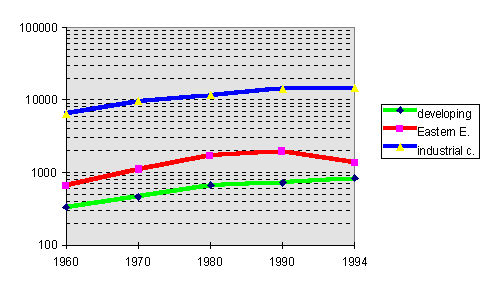
Legend: real income, measured in real GDP per capita in 1987 during the world economic crisis of the 1980s and beyond (semi-log-scale). Our own compilations from UNDP, 1997. The data are:
|
SubSAfrica |
Eastern E. |
Arab States |
East Asia |
Latin America |
South Asia |
SE Asia+Pac |
|
|
1960 |
495 |
658 |
989 |
1122 |
193 |
282 |
|
|
1970 |
598 |
1108 |
1893 |
1435 |
229 |
370 |
|
|
1980 |
634 |
1701 |
2757 |
2379 |
1965 |
363 |
575 |
|
1990 |
514 |
1954 |
1740 |
4674 |
1793 |
462 |
756 |
|
1994 |
507 |
1370 |
1595 |
5759 |
1931 |
514 |
935 |
Dependency has, according to Amin, a commercial, financial and technological aspect. ‘Rent seeking’ - originally a neo-liberal concept, interpreted here from the viewpoint of dependency theory, has its basis in big landholding, which throughout the periphery was introduced, supported and upheld by colonial and post-colonial structures. Profitable investments in many periphery countries are - in part - constrained by the (emerging) unequal income distribution, which again determines, that the local ‘surplus’ is being squandered by luxurious consumption, transferred abroad in the form of capital flight, or being used for speculation. Just to illustrate Amin’s point: in the newly capitalist countries of Eastern Europe, only the Czech Republic, Hungary, and Poland attracted $bn 7.0 or more foreign direct investment. Foreign direct investment in Russia is just $bn 6.5, while recent poverty data on Russia are just alarming. Russia concentrates within its borders around half the income poor of the entire region, numbering in all 60 million poor Russians (poverty is defined here as $4 or less a day). Another 60 million Russians work in the shadow economy or live from crime, that now controls 45% of Russian GNP: and these are statements by the government, and not by Radio Liberty... (Interior Minister Kulikov, quoted in Agence France Press, 2nd July 1997).
In the entire region of Eastern Europe, income poverty increased at an alarming speed between 1988 and 1994 - from 4% to 32% of the total population. 62% of all Russian children and 34% of the aged are poor; the suicide rate increased by more than 50% and the homicide rate more than doubled against 1989. 9.6% of all people are not expected to survive to age 40, 38% of Russians are living below the World Bank absolute world poverty line of a dollar a day, and the Human Development Index has fallen, compared to 1993 (UNDP, 1997). The poorest 20% have an income of 881 $ per capita and year in terms of real purchasing power, while the richest 20% have 12804 $ per capita and year (UNDP, 1997). Our next Graph now shows the twin deficits, that neoclassical economists and dependency authors like Samir Amin alike so much associate with underdevelopment:
Graph 9.9: twin deficits in the newly capitalist countries of Eastern Europe
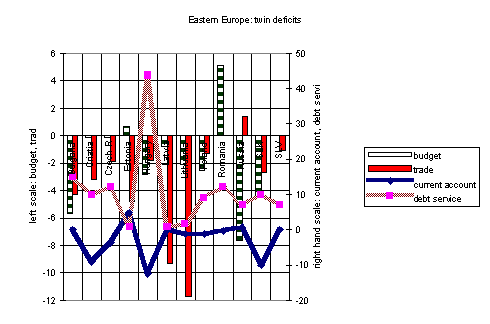
Legend: See inscriptions on the axes. Sources: our own compilations from Business Central Europe, May and June 1997
Past and present foreign domination and colonialism cause long term structural imbalances. Countries as far apart as large parts of Africa and Asia, just as Poland from 1795 - 1918, were no national state during the important era of the Industrial Revolution. Their economies were geared to the needs of others, i.e. their colonizers. The structural heterogeneity between the different economic sectors on the one hand and the ‘modern’, export oriented sector, the medium sector and the ‘traditional sector’ in agriculture, industry and services, became the main reason for the unequal income distribution in the countries of the periphery. Colonial trade, foreign investment in the 19th Century, import substitution in the first half of the 20th Century, and the new international division of labor that we observe from the middle of the 1960s onwards did not really change the structures of inequality in the world system. While mass demand and agricultural structures (Elsenhans, 1983) were responsible for the transition from the tributary mode of production in Western Europe to capitalism from the Long 16th Century onwards, periphery capitalism was and is characterized by the following main tendencies (Amin, 1973 - 1997):
What tendencies, then, do emerge from the multivariate analysis of international development in the post-1980/1989 world in 134 countries with fairly consistent and complete data? Is Arrighi’s hypothesis about the ‘deregulatory logic’ of post-1980 capitalism confirmed by the data? And what about the other hypotheses of ‘world system research’? First of all, MNC penetration (UNCTAD measure, 1985) significantly lowers human development, and increases - ceteris paribus - infant mortality. Under inclusion of the world of former ‘real’ socialism, the curve-linear effect of the development level on subsequent economic growth is partially taken over by variables, pertaining to the employment structure. Both the saturation effects of ‘mature capitalism’ with a high labor force participation rate as well as periphery capitalism’s blocked rural transformation are responsible for slow economic growth. Again, only the statistically significant effects, that cannot be explained by simple random, are being taken into account. Countries with a large labor force participation ratio, and hence, a relatively smaller industrial de-facto reserve army of employment, grow slower than countries at the middle income level with a still larger industrial reserve army. Neoclassical theory would mention here wage flexibility in the urban sector as one of the main underlying processes. But on the other hand, predominantly rural societies at the present stage of globalization are being negatively affected by the ongoing urban bias in world development (M. Lipton). Seen from the perspective of Third World development, it is amazing to see how some European countries repeat the experience of what Armando Cordova and Samir Amin once called ‘structural heterogeneity’ and what development sociologists today call structural disarticulation. Especially those countries, that were once or still are characterized by big landholding and or extensive agriculture, implanted in the world system during the Long 16th Century, like most of the nations of the world’s East and South, are still doomed to slow economic growth, slow human development, and relatively higher infant mortality rates. In terms of measurement, it boils down to the same effect: disarticulation, urban bias, structural heterogeneity - they all happen, whenever agriculture has a much larger share in national labor than in national product, reflecting the relative discrimination of the rural sector in society. The world map of structural disarticulation looks like the following:
Map 9.2: The urban bias of world development
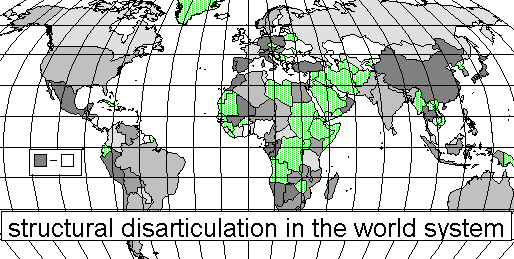
Legend: the darker, the stronger the urban bias in development. Urban bias is measured in terms of the income difference, that separates the rural sector from the rest of society, and is calculated by the share of the agriculturally active population per total employment, divided by the share of agriculture in total GDP. An urban bias factor of 4.5 thus means, that the average monetary income of the rural population is 4.5 times lower than the national average.
Some of the most surprising data from this comparison about the urban bias on a world level are:
|
Austria |
4.0 |
|
Brazil |
2.09 |
|
Germany |
4.0 |
|
India |
2.06 |
|
Israel |
1.33 |
|
Japan |
3.5 |
|
NL |
1.25 |
|
New Zealand |
1.11 |
|
Poland |
4.5 |
|
UK |
1.0 |
|
USA |
2.14 |
Legend: employment share of agriculture, divided by product share of agriculture. For the ongoing debate about this ‘urban bias’, ‘structural heterogeneity’ or ‘disarticulation’ see Huang, 1995; Rothgeb, 1995, Wickrama and Mulford, 1996, as well as the earlier theoretical advances by Amin, 1976; Cordova, 1973, and Lipton, 1977. Our data analysis is based on EXCEL 7 and UNDP, 1996
Hence also the negative effect of agricultural employment on growth. Redistribution of incomes is significantly affected by the ‘Kuznets curve’, by the labor supply rate, and hence, population growth, and by the power status of a nation in the world economy (market size). Katzenstein’s small state theory is not vindicated here anymore. The process of bourgeoisie nation formation (Amin does not use the term ‘nation building’) before the First World War is also a crucial determinant of today’s growth and development chances in the world system. Those nations, that were founding members of the UN in 1945 - and hence have a high UN membership age - disproportionately reap the benefits of economic growth today. The international system indeed seems to work like a single, huge, distribution coalition - or to put in Samir Amin’s words - the international system favors at least some of the five monopolies. Economic growth disproportionately favors countries with a long-established record of UN-membership. Participation in the ‘distribution coalition’ of world power allows for a better access to the distributed goods, while the predominantly rural or semi-rural societies of the ‘Fourth’ and ‘Fifth’ World, but also of the ‘East’ are being excluded from the benefits. Those, that have access in the established networks of distribution coalitions, accumulate even more economic power. The human capital effort, darling of nearly all contemporary models and speeches of the Western development establishment, indeed pays off in terms of economic growth, but not in terms of human development and infant mortality reduction, mainly because of its legacy under totalitarian structures. And Deutsch’s pessimistic stability theory is again vindicated; mainly because a strong state sector role in the economy and low initial exposure to ‘modernization’ (high population growth) still dampen war intensity, while modernization under way (high mean years of schooling) increase conflict intensity.
State sector size affects growth in a way, as predicted by both conventional and radical economic theory. But - contrary to Amin’s expectations - the economic burden of the military sector today also significantly and negative affects economic growth at the level of the 134 nations under analysis. Amin’s own wider theory would allow for such a hypothesis: the state class, and bureaucracies all block against development; militarization, first and foremost, is bureaucratization; while only a handful of nations might reap (if at all?) the benefits of militarily controlling the globe. The effect of militarism must be further qualified: growth is hampered by high military expenditures, but employment is increased. Thus Amin’s hypotheses, derived from his theory, must be qualified: there is a positive employment, but a negative growth effect of monopoly number five in the world system, militarism. Further research should also look into the current account balance effects of militarism and world power political status. High military expenditures are closely linked to the conflict zones of this world, as measured by the indicator War Years from 1990 to 1995.
Also, some results from earlier research are partially contradicted here. Small states do not tend, in Katzenstein’s sense, towards redistribution but towards a higher income inequality; but the economic burden of international power is seen in the negative correlation between absolute GNP and economic growth; or to put it reverse, small markets have a partially optimistic growth perspective. Their growth will tend to be fast, but not egalitarian. Former communist countries could grow rapidly , but often stagnate, not because they are former communist nations, but because their human capital effort is too low, because their peripheral state is too bureaucratic and too big, because their reserve army is too small, because their military burden rate is too high, and because their rural populations are being discriminated against. But per se, the tendencies of world society after 1980 during the new cyclical set-up seem to suggest, that a world political experience as a former communist nation does not block against subsequent economic growth. Again: absolute market size is not a precondition of subsequent economic growth anymore, as successful island nations like Mauritius show impressively. Our equation determines 46.6% of economic growth from 1980 onwards; the F-statistic for the whole equation is 8.05, with 120 degrees of freedom. What flexible specialization has to offer to the megalomania of current European Union thinking, would be open for a debate.
Human development, on the other hand, is positively determined by a high agricultural share, and hence the absence of what Michael Lipton once called the ‘urban bias of world development’. It is being negatively determined by a high ratio of foreign direct investment penetration. Thus, findings of earlier cross-national development research, most notably Huang (1995) are being confirmed anew. Our two statements are very well compatible with the essence of dependency theories. A development, that is dependent to a large extent on foreign capital, is socially polarizing and regionally exclusive. The rural regions stagnate relatively, while the rich urban centers are receiving disproportionate shares of the newly created wealth. But ceteris paribus, it also emerges, that a concerted effort in only one area of human capital formation - education - without the proper health policy effort can be negatively affecting human development. Poland comes to my mind here: education data for Poland are still better than health data, where the need for reform is especially dramatic. Highly repressive totalitarian communist regimes - in the past - had a relatively good quantitative record in the education sector, that was connected with severe deficits in other areas of social policy. This same effect also holds for the determination of infant mortality rates. A policy of high labor force participation ratios, and hence, full employment, less urban bias and chances for rural employment all reduce infant mortality rates significantly, while communist power experience, foreign capital penetration and a one-sided human capital policy, concentrated on schooling, and neglecting health, all contributed significantly to higher infant mortality rates. Employment - here labor force participation rates, is being determined by a Kuznets-type non-linear process. Agricultural structures first block against higher employment ratios in the formal sector, and later on, services, rather than industry, are being able to soak up reserves of unemployment and to guarantee high labor force participation ratios. At later stages of economic development, population growth is positively related to employment; without a certain demographic dynamism, mature societies have indeed to die. Military expenditures are significantly and positively related to higher labor force participation ratios, thus repeating the worst fears about ‘military Keynesianism’ in our age. The war experience of a nation is only weakly determined in our model (14.9%); yet, the most significant results are achieved by the state sector and low social mobilization (high population growth), working against a prolonged war experience, while military expenditures and mean years of schooling enhance the conflict potential: the state neutralizes violence potential, while modernization and social mobilization increase it. Finally, income inequality is being determined - in an almost brutal Wallersteinean sense - (41.3%) - by the Kuznets curve, population growth, and by the absence of a position of power in the international system (absolute GNP).
Table 9.11 and Graph 9.10: towards an age of de-regulation? Bivariate and multivariate analyses
a) determinants of growth
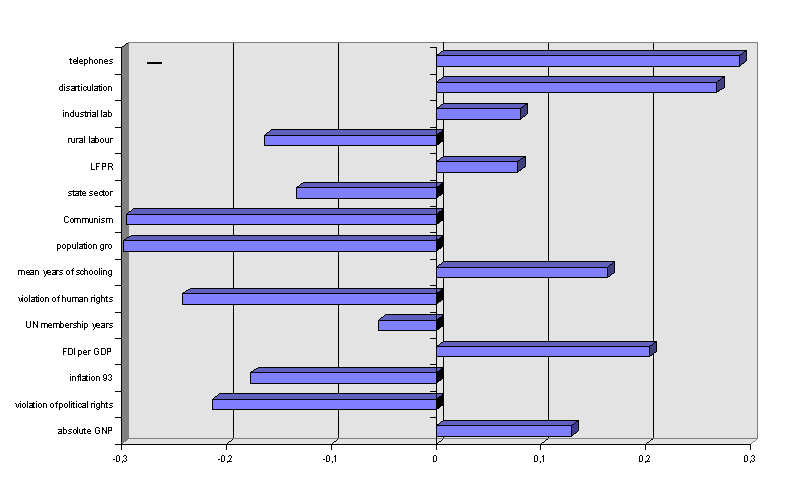
Legend: Pearson-Bravais correlation coefficients of economic growth with different predictor variables (see inscriptions) for the countries of the world system
b) determinants of human development
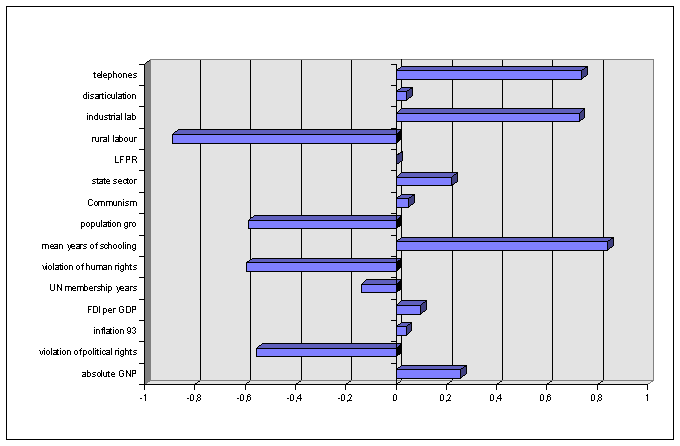
Legend: Pearson-Bravais correlation coefficients of the human development index with different predictor variables (see inscriptions) for the countries of the world system
|
a) GROWTH |
|||||||||||||
|
10,213 |
0,27658 |
-0,0449 |
-0,0038 |
0,04683 |
0,04623 |
-0,0412 |
-0,9458 |
-0,0299 |
-0,0034 |
1E-04 |
-0,372 |
-0,0035 |
-4,1729 |
|
2,44484 |
0,09678 |
0,02556 |
0,03757 |
0,02002 |
0,03517 |
0,01661 |
0,25246 |
0,01213 |
0,01112 |
0,0003 |
0,13 |
0,01406 |
3,1815 |
|
0,466 |
|||||||||||||
|
8,04862 |
120 |
||||||||||||
|
4,177 |
2,858 |
-1,755 |
-0,1006 |
2,339 |
1,31457 |
-2,481 |
-3,746 |
-2,463 |
-0,308 |
0,33523 |
-2,861 |
-0,2517 |
t-test |
|
UN memb.y |
mean y scho |
absoluteGNP |
FDI per GDP |
Years of Comm |
population gr |
state sector |
%labor force |
%lf agric. |
%lf industry |
agr.shareGP |
MILEX |
HDI |
constant |
|
b)HUMAN DEVELOPMENT |
|||||||||||||
|
UN memb.y |
mean y scho |
absoluteGNP |
FDI per GDP |
Years of Comm |
population gr |
state sector |
%labor force |
%lf agric. |
%lf industry |
agr.shareGP |
MILEX |
constant |
|
|
-0,0017 |
-0,0042 |
-6E-05 |
-0,003 |
-0,0018 |
-0,0002 |
-0,0134 |
0,00027 |
0,00053 |
-7E-06 |
0,02086 |
-0,0001 |
0,86611 |
|
|
0,0036 |
0,00087 |
0,0014 |
0,00069 |
0,0013 |
0,00062 |
0,00931 |
0,00045 |
0,00041 |
1,1E-05 |
0,00445 |
0,00052 |
0,08829 |
|
|
0,88 |
|||||||||||||
|
74,1983 |
121 |
||||||||||||
|
-0,4828 |
-4,78 |
-0,0435 |
-4,383 |
-1,3488 |
-0,3169 |
-1,4343 |
0,59058 |
1,29988 |
-0,6638 |
4,691 |
-0,2103 |
t-test |
|
|
UN memb.y |
mean y scho |
absoluteGNP |
FDI per GDP |
Years of Comm |
population gr |
state sector |
%labor force |
%lf agric. |
%lf industry |
agr.shareGP |
MILEX |
constant |
|
|
mean y scho |
absoluteGNP |
FDI per GDP |
Years of Comm |
population gr |
state sector |
viol hum rites |
%lf agric. |
%lf industry |
agr.shareGP |
MILEX |
||
|
c) EMPLOYMENT |
-0,9723 |
-0,2063 |
0,06753 |
0,13692 |
2,14696 |
0,05062 |
1,33109 |
-0,2628 |
-0,2096 |
4,1E-05 |
2,07067 |
18,7369 |
|
0,63941 |
0,14877 |
0,2391 |
0,11011 |
1,10838 |
0,10571 |
1,61876 |
0,07624 |
0,06768 |
0,00188 |
0,73014 |
12,7789 |
|
|
0,293 |
||||||||||||
|
4,60169 |
122 |
|||||||||||
|
-1,5206 |
-1,387 |
0,28244 |
1,2435 |
1,93703 |
0,47887 |
0,82229 |
-3,4465 |
-3,0963 |
0,02195 |
2,836 |
t-test |
|
|
mean y scho |
absoluteGNP |
FDI per GDP |
Years of Comm |
population gr |
state sector |
viol hum rites |
%lf agric. |
%lf industry |
agr.shareGP |
MILEX |
|
d) INFANT MORTALITY |
||||||||||||
|
UN memb.y |
mean y scho |
absoluteGNP |
FDI per GDP |
Years of Comm |
population gr |
state sector |
%labor force |
%lf agric. |
%lf industry |
agr.shareGP |
MILEX |
constant |
|
0,02855 |
0,32736 |
-0,2226 |
0,5792 |
0,53384 |
0,11911 |
2,52969 |
-0,2306 |
-0,1964 |
0,00208 |
-4,1766 |
0,0939 |
13,9921 |
|
0,83446 |
0,20233 |
0,32428 |
0,16052 |
0,30125 |
0,14331 |
2,16057 |
0,10451 |
0,0953 |
0,00256 |
1,03204 |
0,12131 |
20,4932 |
|
0,811 |
||||||||||||
|
43,3413 |
121 |
|||||||||||
|
0,03421 |
1,618 |
-0,6864 |
3,608 |
1,772 |
0,83112 |
1,17084 |
-2,206 |
-2,061 |
0,81363 |
-4,047 |
0,77406 |
t-test |
|
UN memb.y |
mean y scho |
absoluteGNP |
FDI per GDP |
Years of Comm |
population gr |
state sector |
%labor force |
%lf agric. |
%lf industry |
agr.shareGP |
MILEX |
constant |
|
viol pol rites |
mean y scho |
absoluteGNP |
FDI per GDP |
Years of Comm |
population gr |
state sector |
%labor force |
%lf agric. |
%lf industry |
agr.shareGP |
MILEX |
HDI |
|
-13,4614 |
0,83461 |
0,04328 |
0,15409 |
0,11675 |
-0,33473 |
-0,17015 |
-0,16198 |
-0,09705 |
-0,01932 |
-0,00094 |
1,7409 |
0,66349 |
|
12,1148 |
0,48782 |
0,12636 |
0,18622 |
0,09847 |
0,17369 |
0,08252 |
1,27292 |
0,0601 |
0,05313 |
0,00147 |
0,65095 |
0,63394 |
|
0,149 |
||||||||||||
|
1,61588 |
120 |
|||||||||||
|
-1,11115 |
1,7109 |
0,34251 |
0,82748 |
1,18565 |
-1,927 |
-2,062 |
-0,12725 |
-1,61495 |
-0,3636 |
-0,63412 |
2,6744 |
1,0466 |
|
viol pol rites |
mean y scho |
absoluteGNP |
FDI per GDP |
Years of Comm |
population gr |
state sector |
%labor force |
%lf agric. |
%lf industry |
agr.shareGP |
MILEX |
HDI |
|
constant |
|
12,9576 |
|
15,742 |
f) income inequality
|
INCOME |
ln PPP |
(ln PPP)^2 |
mean y scho |
absoluteGNP |
FDI per GDP |
Years of Comm |
population gr |
state sector |
%labor force |
%lf agric. |
%lf industry |
agr.shareGP |
|
INEQUALITY |
-0,2335 |
-0,1353 |
-0,0849 |
-0,1051 |
0,01724 |
-0,0049 |
3,23042 |
-0,0236 |
0,00432 |
-6E-05 |
-0,3733 |
-0,5457 |
|
0,25144 |
0,06956 |
0,09698 |
0,05241 |
0,10312 |
0,04445 |
0,64893 |
0,03575 |
0,02768 |
0,00079 |
0,3202 |
0,61236 |
|
|
0,413 |
||||||||||||
|
6,50195 |
120 |
|||||||||||
|
-0,9286 |
-1,946 |
-0,8756 |
-2,004 |
0,16716 |
-0,111 |
4,978 |
-0,6614 |
0,15599 |
-0,0814 |
-1,1657 |
-0,8911 |
|
|
ln PPP |
(ln PPP)^2 |
mean y scho |
absoluteGNP |
FDI per GDP |
Years of Comm |
population gr |
state sector |
%labor force |
%lf agric. |
%lf industry |
agr.shareGP |
|
MILEX |
constant |
|
6,41566 |
36,2921 |
|
10,3385 |
47,0594 |
|
0,62056 |
0,7712 |
|
MILEX |
constant |
Legend: War years (as of December, 1995) are calculated from D. Smith, 1997. Income inequality data are estimated from World Bank, WDR 1996, UNDP HDR 1996 and Moaddel, 1994. The existing data were augmented by averages of non-linear, second-order polynomial trend-line estimates of existing income inequality data projected onto the countries with missing data, with labor force participation rates and mean years of schooling serving as the two predictors. The choice of the predictors was made by calculating the highest linear correlation coefficients of income inequality data with the main variables of the model. The original war data are listed in the Appendix, and were coded by subtracting the year, in which a war began, from the final year of a war (if unfinished, then 1995). Wars, which lasted less than a year, are coded as ‘1’. Source: our EXCEL 5.0 and 7.0 calculations from UNDP and other data sources, quoted above. As in all EXCEL 5.0 outprints in this work, first row: unstandardized regression coefficients, second row: standard errors, last row: t-Test. The values immediately below the standard errors are R^2 (third row, left side entry), F, and degrees of freedom (fourth row).
In terms of employment policy and future labor force participation rates, Europe is not in a very lucky constellation right now. We have again and again stated this throughout this work: low population growth, a strong urban bias, high overall educational levels, combined with a high employment share of industry and a run-down of military expenditures all would suggest a future lowering of the labor force participation rates, while in some European countries there is still a high agricultural employment share, which works as an additional constraint against a higher labor force participation ratio. The urban bias of European development, in the end, could become the major stumbling block of the European Union. This explosive mix of problems is made all the worse by faltering economic growth, determined downward by high state sector ratios, a dried-up reserve army of labor, and too high military expenditures, that, under the inflexibilities of really existing capitalism, are often the only way out to prop up employment.
These results are all the more deplorable, since in terms of internal redistribution, the European Union has been more efficient than other existing trade blocks around the world. The Union policy of redistribution to the Mediterranean South could have been more efficient, would it not have been accompanied by the above mentioned high social structural disarticulation rates in Mediterranean agriculture, which are, if we again correctly follow Samir Amin, nothing but the consequence of the expansion of capitalism east- and southward during the Long 16th Century, made all the worse by the effects of heavily subsidized agricultural exports from the Union. Millions and millions of ECU have reached since the mid 1980s the poorer regions of Europe’s South, thus homogenizing Europe’s economic regions to a great extent. Our empirical measurement of these phenomena starts out from the assumption, that the Human Development Indicator is indeed the single best measurement scale for the analysis of the social conditions of states in world society. We compare here the EU 12, and samples of the kernel of the ASEAN states with complete data, EFTA, APEC, NAFTA, and the EU associated countries since the 1980s. Our analysis can only be tentative, since there are problems of missing data and, above all, also shifting and overlapping memberships, that had to be taken care of. Nevertheless, we think that our choice of states to be analyzed with complete data is relatively balanced and fair. In each case, we compare the standard deviation of the different integrative units and their relative predecessors or processes in the making for 1980, 1992, and 1994, and arrive at the following Graph by putting the 1980 value at 100 each. For comparison, the original values about HDI standard deviations and mean values of HDIs from 1980 onwards are given in the following graph:
Graph 9.11: The redistribution effect within integrative units. EU12 compared (standard deviations of Human Development Indices in the trade blocks by 1980 are set at 100 each)
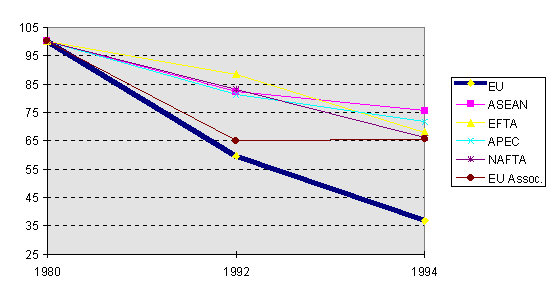
Legend: standard deviations of HDIs (human development indices) in the different trade blocks of the world economy. As to the samples and original data for this graph, see Appendix.
Graph 9.12: The absolute values of the average Human Development Indices and their standard deviations in each trade block since 1980
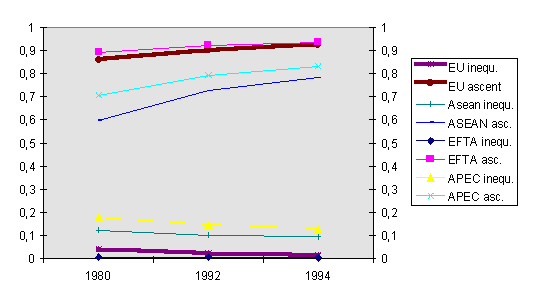
Legend: absolute values of average Human Development Indices per trade block (lines above, right hand scale) and standard deviations of HDIs within each trade blocks (lines below, left-hand scale). The thick lines symbolize the European Union.
The Rotten Heart of Europe? A technical note on EMU and the rise of world-wide narco capitalism
The above mentioned positive redistribution effect on a European scale between the North and the South (and later on, between the West and the East) could be endangered by the long-term effects of EMU. The proponents of EMU maintained all along, that it will be engine of political and economic unification on the continent. We fear, that the long-term effect of the project will be an increasing nationalism and a cultural conflict along the old cultural frontier, the Limes, between the Latin and the Germanic Europe, between the wine and the beer culture, between the olive oil consumers and the sausage eaters. This is the main hypothesis of the following Chapter. And this is not a Chapter against the EMU, it is a Chapter against Euro-monetarism. An increasing number of scholars propose an alternative course of action, that stresses the political and social cohesion in Europe as the main pillars of a true European Monetary Union (Rothschild, 1997). There is the danger, that Euro-monetarism will accelerate the tendency of the world system on its path towards financial speculation, narco-capitalism, and the shifting of resources away from the Atlantic region towards the Pacific. On the other hand, it is evident that Europe’s long-term ascent from the Long 16th Century onwards from the state of a former periphery of the world system to a center (Arrighi, 1995; Amin, 1975), which was based on agrarian reform and mass demand, is now threatening to be reversed by the application of monetary orthodoxy. The Maastricht debate is characterized by the following basic fallacies: Fallacy number one: by high unemployment you can control inflation. At the outset of this technical appendix, we would thus like to state that unemployment, first of all, is an enormous waste of economic resources. For 18 western democracies with complete UNDP (or Federal Ministry of Labor of the Republic of Austria) data for 1995, we have:
Graph 9.13: Unemployment is a waste of resources
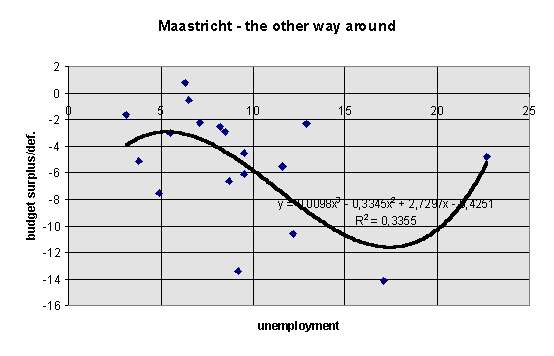
Legend: unemployment rates (x-axis) and budget balances (y-axis, per GDP) in OECD countries. Compiled from data series, published in the international press, 1998
Thus, only at very small and at very high levels of already existing unemployment, a ‘shock therapy’ might work to flatten out budget deficits. But else, there is an across the board negative correlation between unemployment and budget surplus, i.e. increasing unemployment still increases deficits. Saving has limits. And here, the sad story of Euro-‘monetarism’ begins (the hyphens are to indicate, that the relationship between real monetarist theory of the Milton Friedman type to contemporary European applications is far from certain; see also Friedman’s excellent essay on the EURO, 1997:
‘Jacques Rueff, fierce 1950s critic of American monetary hegemony, once said: ‘Europe will be built through a currency or it will not be built at all’. What the ERM story shows is quite the opposite: trying to lock countries like France and Germany together via their currencies does not forge one nation; instead it turns domestic monetary questions into international political conflicts’ (Connolly, 1995: 1995)
It is time to stress the fundamental weaknesses of the EMU project from the viewpoint of world system theory. Up to now, Europe does not form an integrated economic region with truly European transnational corporations; Europe forms only a preferential market (Amin, 1997). Secondly, Europe does not have a continental societal project, that would integrate such areas as research and development, public markets, and would have a joint commercial and corporate law, and as yet does not integrate the vital sectors of film and TV production. Trade union and other social law would have to be integrated, and Europe does not have as yet a joint project of external relations with the other regions of the world economy (Amin, 1997; Friedman, 1997). The EMU project should facilitate a truly common market, the free movement of capital and stable external exchange rates. As the critics of the project have shown all along, the project could only function if there is a parallel economic and social policy in the member states of EMU; that means harmonization of tax and expenditure systems, the integration at the level of corporate policy, and the harmonization of trade union policy at the European level. There would have to be a coordinated European policy not only of the internal, but also of the external opening of markets - especially regarding foreign investment and capital inflows from third countries (Amin, 1997). The ongoing negotiations on the Mutual Agreement on Investment (MAI) run counter to the very spirit of a European social area; as Jadwiga Staniszkis, as a lone preacher in the desert, has repeated here in Poland. We all know by today the Maastricht criteria (Rothschild, 1997) and the ‘shopping list’ of anti-EMU arguments:
Fallacy number two now arises: that economic theory supports the EURO. Academic economists found 24 main arguments against the EURO:
Fallacy number three now consists in the assumption, that you can exclude the shadow economy and its accumulated savings from the EURO debate. A new currency will mean for the gangsters: open the money suitcases and try to exchange or place any bill that is not yet placed. But for many members of the huge and growing criminal underworld (there were 87 prisoners per 100000 population in the EU alone in 1993; i.e. a rise against the 77 per 100000 in 1987) the question of EMU is also a fundamental one: emerge with the cash? Place it somewhere? Exchange it for $ bills? To give an impression of the size of the criminal underworld, it might suffice here to state that in EU countries alone, there is a prison population of about 320000 people. Extending the Union eastwards and including the Czech Republic, the Slovak Republic, Hungary, Romania, Bulgaria and Poland, would mean adding to it another 153000 people to this entire army. Just to give an imagination about the size of the problem, it might suffice here to state that by comparison, the entire armed forces of the European Union are only 2068000 people (all data calculated from UNDP, 1997). The battle over the EMU-project now unfolds on the international financial markets. On paper, the USA face the same current account balance trends as Germany faced them - to be weighted at any rate by the role of the $ in international transactions. Until recently, ‘their’ American-Asian-Pacific economic space attracted - mainly via the Japanese bank - a large percentage of the surplus capital of the world, partly also, because both legal and illegal funds, in anticipation of the EURO, flowed to that region. Japan’s high official current account balance also pointed in a downward direction, but currency reserves go up - a clear indicator for the hypothesis, that both legal and illegal world surplus capital flows into Japan. Only experience will be able to tell us, how the recent currency crisis in East Asia is connected to major possible ‘tectonical shifts’ in international crime, international finance and surplus flows. It is entirely possible that a briefer strength period of the European currencies in the run-up to the EURO, will be followed months or years later, by a renewed Asian-oriented flow. Let us not underestimate especially the economic power of the Japanese Yakuza, the richest criminal organization in the world. The profit opportunities for the international speculators are enormous - 1997: rock the boat in Asia, jump in profits number one. Method: lending of local overvalued currencies, selling it into $ or European currencies. Pay back calmly your credits in local currencies, which are severely down. Now, 1998: perhaps rock the boat in Europe. Method: lending of Lira, selling it into $ or Asian currencies. Pay back calmly your Lira credits, which are worth nothing anymore. Now, 1999: rock the boat in America: Method: lending of $, selling it into Asian currencies. Pay back calmly your $ credits, which are worth nothing anymore as Asia recovers and the Arrighi cycle of financial transfers from the Atlantic to the Pacific nears its finish; America then stumbles, because of its current account.
On a world level, it is also absolutely unrealistic to overlook the power of international drug cartels and other criminal groups. 20 ‘narco states’ (soft on drugs, according to the US State Department terminology, US State Department, 1996) had a considerable power over international reserves. The leading ‘drug countries’ with comparable data (see list at the end of the graph) control already $bn 324.137 currency reserves, while the 10 leading western industrial democracies and financial places (Japan, USA, Germany, France, United Kingdom, Italy, Spain, Austria, Switzerland, Sweden) still control $bn 739.707. After the three-fold rock the boat strategy around the globe is finished, the gangsters and speculators will have been able to shift then this relationship decisively, to perhaps $bn 500 to 500 or even worse. Already today, an alarming proportion of OECD country currency reserves at any rate also stem from the proceeds of money laundering, as the comparison between current account balances and international reserves suggests:
Graph 9.14: International reserves of 20 narco states and 10 leading western democracies
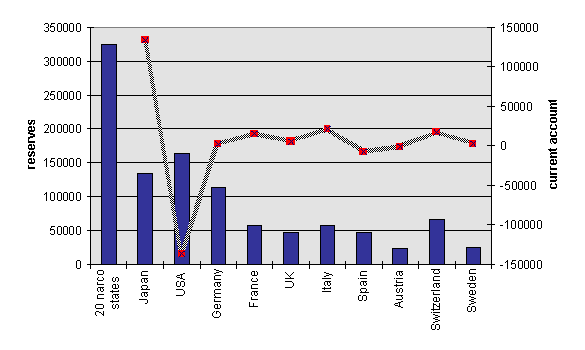
Legend: international reserves - bars, left-hand scale; current accounts - dotted line, right-hand scale in 1000 $. The currency reserves of the narco states are the following:
|
Bolivia |
793 |
|
Brazil |
38492 |
|
Taiwan |
97653 |
|
China |
57781 |
|
Dom R |
259 |
|
Ecuador |
2003 |
|
Guatemala |
943 |
|
India |
24221 |
|
Colombia |
7862 |
|
Lao PDR |
68 |
|
Lebanon |
4210 |
|
Malaysia |
26339 |
|
Mexico |
6441 |
|
Myanmar |
518 |
|
Nigeria |
1649 |
|
Pakistan |
3716 |
|
Paraguay |
1030 |
|
Peru |
7420 |
|
Thailand |
30280 |
|
Venezuela |
12459 |
|
20 narco states |
324137 |
Definition: A narco state is understood here as a country, figuring on the list of statements of explanation by the US Department of State International Narcotics Control Strategy Report, 1996
Even the most powerful capitalist nations are - due to the mechanisms of international financial markets, practically at the mercy of the currency reserves accumulated in the 20 leading narco states of the South (international reserves):
Graph 9.15: The share of narco states in international reserves of the main world financial centers
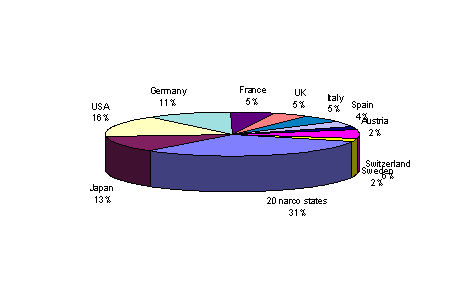
Legend: the share of different groupings in world-wide currency reserve holdings, end-1997. Our own calculations from Fischer Weltalmanach and the international press.
In the direct comparison between Japan, the US and Germany, we also see the basic weakness of the Deutschmark against the main contenders:
Graph 9.16: currency reserves and current account balances since 1990 in the world system - Germany, Japan and the USA compared
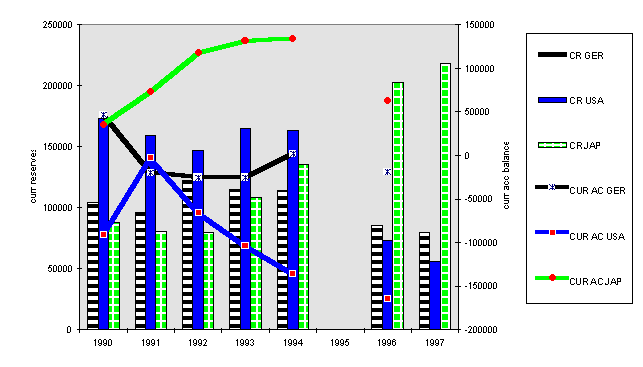
Legend: current account balances: columns (right-hand scale); currency reserves: lines (left-hand scale)
Legend: data and projections on the current account balances of Germany, Japan, and the United States of America from 1990 onwards
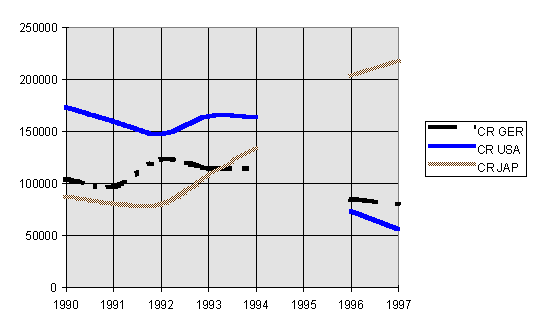
Legend: currency reserves in the major capitalist centers from 1990 onwards
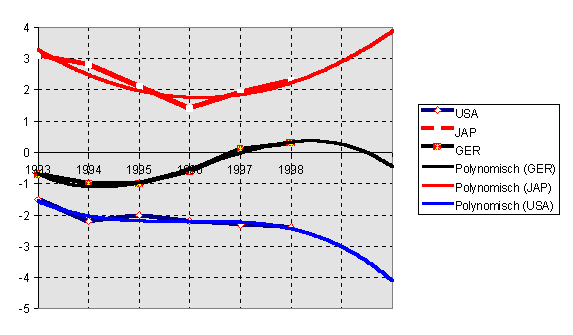
Legend: current account balances per GNP; and projections about their future development. Sources: Data for the last Graph are IFRI (1998), the other data were from Fischer Weltalmanach and Economist:
|
CR GER |
CR USA |
CR JAP |
CUR AC GER |
CUR AC USA |
CUR AC JAP |
|
|
1990 |
104547 |
173094 |
87828 |
46800 |
-92160 |
35870 |
|
1991 |
96657 |
159273 |
80626 |
-19497 |
-3690 |
72905 |
|
1992 |
122686 |
147526 |
79697 |
-25563 |
-66380 |
117640 |
|
1993 |
114822 |
164620 |
107989 |
-25563 |
-103925 |
131510 |
|
1994 |
113841 |
163591 |
135145 |
2327 |
-136484 |
133900 |
|
1995 |
||||||
|
1996 |
85300 |
73200 |
202700 |
-18500 |
-165100 |
63400 |
|
1997 |
80200 |
56200 |
218200 |
Asia’s hour will still come, while Maastricht tries to achieve a stability that it can never achieve. One of the real reasons of financial instability on a global scale is to be found in the ever-larger share of drug money in international reserves and savings. $85 billion in drug profits are laundered through the financial markets each year, with an upward tendency. With total world savings at 22% of world GNP (25385 US$ billions), these profits are 1.5% of world savings. The volume of the drugs trade - at least $bn 500 - is 9% of world savings and approximately double the size of the largest single currency holdings of any country in the world system, Japan. The drug lords could ruin the international financial system. Maastricht walks another path - that of financial austerity, to bring about financial stability. The present ‘working poverty’ US boom, on the other hand, will definitely come to a halt. World system theory argues here, that hegemonic capital leaves the hegemonic centers during eras of the de-legitimatization of the world system, after the period of world hegemony, lasting one Kondratieff cycle, came to an end (Chase-Dunn and Hall, 1997).
Another fallacy, fallacy four, of the Maastricht process is that it excludes the option of full employment. UNDP-data 1996 show that labor force participation rates and inflation rates in the highly developed countries had quite a negative correlation with each other which flattens off only at very high levels of employment, thus indicating certain limits of the ‘NAIRU’ debate (‘non-accelerating inflation rate of unemployment’)(Beirat, 1996). Maastricht policy brings about not only short-term, but also middle range and long-term unemployment; which - in the long run - is a very costly strategy, even increasing the very inflation process.
Graph 9.17: unemployment, labor force participation rate and inflation in developed capitalism
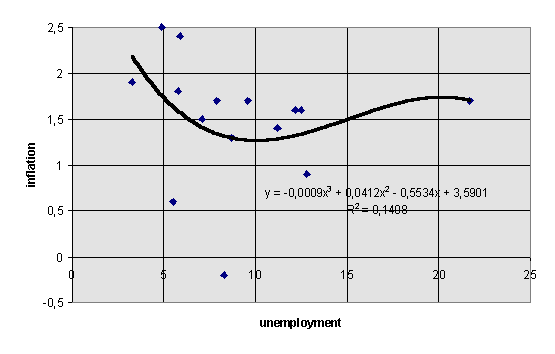
Legend: unemployment (x-axis) and inflation (y-axis) in developed OECD democracies. Data: our own compilations from Fischer Weltalmanach, The Economist, and other international media.
Since official unemployment statistics tell us only half the story about unemployment, the negative influence of labor force participation rates on inflation are telling indeed:
9.17 (continued)
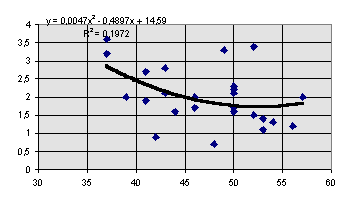
Legend: employment rates (x-axis) and inflation rates (y-axis). Sources: the following UNDP 1996 data were used:
|
LFPR |
inflation |
|
|
Canada |
53 |
1,4 |
|
USA |
50 |
1,7 |
|
Japan |
52 |
3,4 |
|
NL |
46 |
1,7 |
|
NOR |
50 |
2,2 |
|
SF |
52 |
1,5 |
|
France |
44 |
1,6 |
|
Iceland |
56 |
1,2 |
|
Swed |
54 |
1,3 |
|
Spain |
41 |
2,7 |
|
Australia |
50 |
1,6 |
|
Belgium |
41 |
1,9 |
|
Austria |
46 |
2 |
|
NZ |
48 |
0,7 |
|
CH |
53 |
1,1 |
|
UK |
50 |
2,3 |
|
DK |
57 |
2 |
|
GER |
50 |
2,1 |
|
IRE |
37 |
3,6 |
|
ITA |
43 |
2,1 |
|
GRE |
42 |
0,9 |
|
ISR |
39 |
2 |
|
LUX |
43 |
2,8 |
|
MAL |
37 |
3,2 |
|
POR |
49 |
3,3 |
Fallacy five consists in overlooking what a ‘hard’ EURO will mean for the European exporter. Like in the former GDR, it will mean an enormous upward push in the price of export goods on world markets. This analysis maintains all along, that factors, like the position in the world economy, are far more important variables than mere monetary aggregates. So why should Germany push so hard for a ‘hard EURO’? The hypothesis, that German corporations and banks, by a policy of a hard EURO, rather tend towards eliminating present and future unwelcome competitors from the closed European home market, instead of providing the European backbone in the trilateral competition between Asia, America, and Europe, finds further support by a look at the current account balances of the world’s leading industrial nations, in comparison with the EU, by around end 1996:
Graph 9.18: European current account balances by international comparison
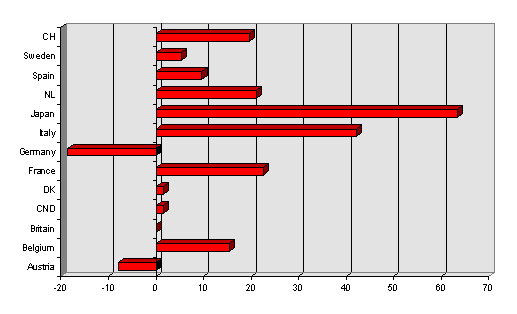
Legend: current account balances in OECD democracies. Sources: for this and the following graphs, we used Fischer Weltalmanach and Economist data
When proponents of the EURO in Germany (and Austria) maintained that it will mean a welcome future exclusion of competitive de-valuations, this argument overlooks the fact, that hundreds of countries can still competitively de-value, while the less than a dozen member countries of EMU cannot. Faced with an ever stiffer competitive pressure from the world markets, Germany and her northern European partners indeed seem to be inclined to a policy of monetarily regulating, if not dominating, the chances for export of the European continent. Only a ‘hard’ EURO would prevent profoundly enough the unwelcome low-value-currency-driven competition from the European mezzogiorno countries, a competition, which is, nota bene, partly the result of the run-away of the very German (and other Northern European) productive capital abroad under present-day social and policy regulations. A closer look at the trade-weighted exchange rates of major European and world currencies also shows to us that an upward pressure on the Deutschmark, should the EMU project fail, would not be maintainable in the long-run, a short and desperate attempt to create a mini-EMU after a possible failure of the large EMU project notwithstanding. A third path would be to ‘recycle’ German and other northern European savings into real transfers towards the Mediterranean EU countries, and later, the East. But it would be politically unthinkable in the long run and would create enormous pressures on the labor markets and for export industries. The story of exchange rates over 1996/97 is quite different from what politicians sometimes pretend. The strength of the Deutschmark is a myth:
Graph 9.19: trade-weighted exchange rates since 1990
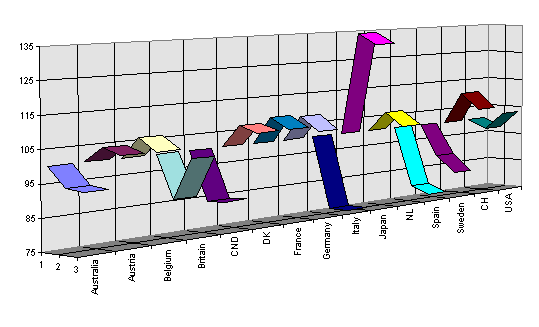
Legend: trade-weighted exchange rates of major OECD currencies since 1990 (=100). Our own compilations from the Dialog-archive (http://www.dialogselect.com)
Fallacy six consists in overlooking the real weakness of the D-Mark over recent months, and it also consists in overlooking that this trend will continue. Short of direct speculation, the following swings could be tentatively interpreted, without maintaining any rigor from that first inspection of the empirical data:
Graph 9.20: The projected rise of the $ and the fall of major currencies
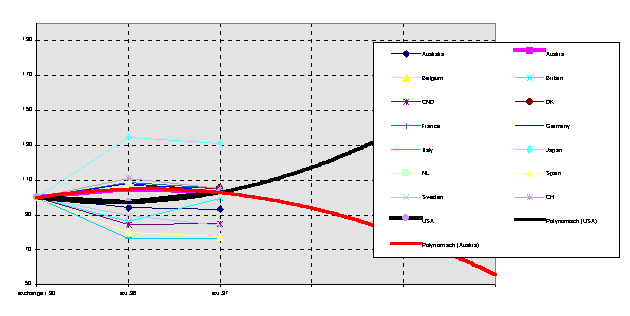
Legend: our own compilations about trade-weighted exchange rates (1990=100); see above
Already, in more analytical terms, the following cross-national analyses from the ups and downs of the exchange rates are possible, using the data base of the ‘Economist’ newsmagazine (Economic Indicators, comprising GDP growth, unemployment, inflation, current account balance per GDP, growth rate of broad money supply (M2), interest rates (banks prime rate), foreign reserves) for 12 leading economies in the world over 1996/97. Available data series also show, that the obsession with inflation should give way to an obsession with economic growth. The ups and downs of the exchange rate are determined primarily by economic growth (‘the basics’), and not by monetary aggregates. Since I am not a monetary economist, such a heterodoxy does not bother me at all. Thus, we expect an underlying, basic strength of the US $ for 1997 and 1998, since America will have a stronger growth than Europe:
Table 9.12: the determinants of the 1996/97 exchange rate rise or fall
|
interest r |
dyn gdp |
inflation |
current acc |
constant |
|
-0,194708194 |
3,906341351 |
0,198525086 |
0,651907557 |
-11,13735669 |
|
0,492759217 |
1,853312658 |
1,037989266 |
0,555292814 |
4,812306156 |
|
0,571097567 |
||||
|
3,32883147 |
10 |
|||
|
-0,395138614 |
2,107761653 |
0,191259286 |
1,173988824 |
t-Test |
|
dyn m2 |
dyn gdp |
inflation |
current acc |
constant |
|
-0,581775269 |
3,836251645 |
-0,436197965 |
0,43290356 |
-7,733318113 |
|
0,416297207 |
1,848356602 |
0,95437895 |
0,348103742 |
3,066290195 |
|
0,57734929 |
||||
|
3,415049808 |
10 |
|||
|
-1,397499812 |
2,075493246 |
-0,457049021 |
1,243605017 |
t-Test |
Legend: as in all EXCEL 5.0 outprints in this work, first row: unstandardized regression coefficients, second row: standard errors, last row: t-Test. The values immediately below the standard errors are R^2 (third row, left side entry), F, and degrees of freedom (fourth row).
The case for reflating Europe’s economies can even be stated in a provocative fashion:
Graph 9.21: growth, consumer price rises (1997 in %) and changes in the trade-weighted exchange rate, 1996/97
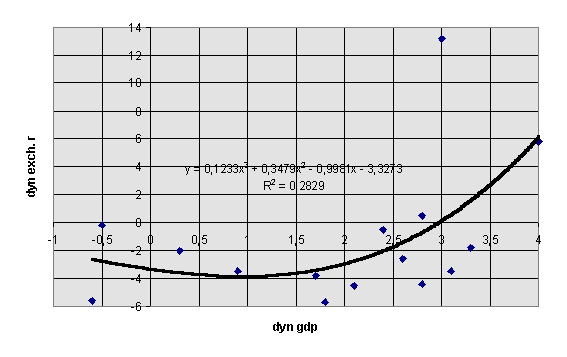
Legend: economic growth (x-axis) and growth of the value of the exchange rate (y-axis) in major OECD democracies. Our own compilations from Economist and Dialog archive.
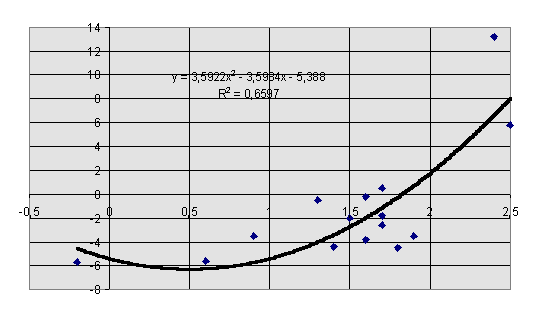
Legend: inflation (x-axis) and exchange rate dynamism (y-axis); see above
Post-hoc predictions from an anti-shock-strategy model for the real observable data 1996-97 show, that the Graph above strikingly corresponds to realities:
|
dyn exchange rate |
trend dyn exchange rate 1997 |
|
|
-0,5 |
-3,995184827 |
Australia |
|
-2 |
-2,703252268 |
Austria |
|
-3,8 |
-1,949520884 |
Belgium |
|
13,2 |
6,666692706 |
Britain |
|
0,5 |
-1,123946096 |
CND |
|
-1,8 |
-1,123946096 |
DK |
|
-3,5 |
-5,716929108 |
France |
|
-4,4 |
-3,385140249 |
Germany |
|
-0,2 |
-1,949520884 |
Italy |
|
-3,5 |
0,742733688 |
Japan |
|
-4,5 |
-0,226527905 |
NL |
|
-2,6 |
-1,123946096 |
Spain |
|
-5,7 |
-4,524645115 |
Sweden |
|
-5,6 |
-6,253881584 |
CH |
|
5,8 |
8,067014719 |
USA |
One consequence of this empirical relationship between inflation and upward movements in the trade-weighted exchange rates is a prediction of the behavior of the major currencies on the world markets in 1998. The prediction is based on the Economist’s prediction of inflation in Europe and in the major other economies of the world in 1998
Economist predictions of inflation for 1998
|
predicted inflation 98 |
|
|
2,9 |
Australia |
|
2,3 |
Austria |
|
2,1 |
Belgium |
|
3,2 |
Britain |
|
2,1 |
CND |
|
2,7 |
DK |
|
1,9 |
France |
|
2,1 |
Germany |
|
2,6 |
Italy |
|
1,2 |
Japan |
|
2,6 |
NL |
|
2,6 |
Spain |
|
1,7 |
Sweden |
|
1,4 |
CH |
|
3,1 |
USA |
The consequence of this assumption then would be the prediction of the exchange rate dynamics for 1998:
|
trend dyn er 1998 |
|
|
-3,896702 |
Australia |
|
-2,60315 |
Austria |
|
-1,848608 |
Belgium |
|
6,774112 |
Britain |
|
-1,022222 |
CND |
|
-1,022222 |
DK |
|
-5,621678 |
France |
|
-3,285848 |
Germany |
|
-1,848608 |
Italy |
|
0,846082 |
Japan |
|
-0,123992 |
NL |
|
-1,022222 |
Spain |
|
-4,438232 |
Sweden |
|
-6,161048 |
CH |
|
8,17525 |
USA |
If you want to invest your money in Sterling or US $, do it. Do not go in for Swiss Franks, Deutschmark, Swedish crowns, or French Francs, or Lira:
Graph 9.22: $ and Sterling - superstars 1998. Predicted exchange rate dynamics, 1998 in %
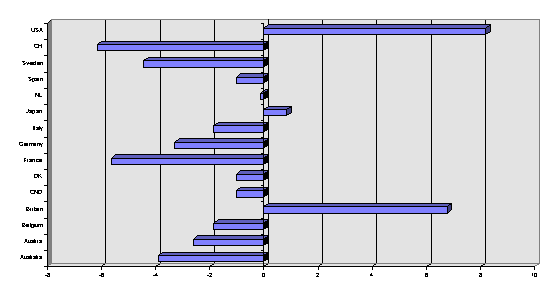
Legend: our predictions for the 1998 exchange rate dynamism
Fallacy seven is equally important as the six previous ones. It consists in overlooking the effects of illegal money on Europe’s poorer East. A hard EURO would attract an enormous amount of illegal Eastern capital to Western Europe, while the crooks will not hesitate to change their partially existing D-Mark wealth into $ or other non-EURO currencies, should the need arise. Market imperfections and the peripheral position of Eastern Europe in the world economy cause a tendency towards a secular current account balance deficit in most of the new democracies (at least those with historical records of big landholding and a weak national state), that can practically only be closed by the shadow economy, including illegal migration and money laundering:
Table 9.13: economic performance in Central and Eastern Europe, 1997:
|
GDP |
budget |
unemployment |
inflation |
current acc |
reserves |
debt |
|
|
Bulgaria |
11,6 |
-12 |
16,3 |
1972,5 |
0 |
0,5 |
10,3 |
|
Croatia |
18,8 |
-0,9 |
16,7 |
4,4 |
-1,5 |
2,2 |
4,1 |
|
Czech R |
52,7 |
0,5 |
3,9 |
6,7 |
-4,5 |
12 |
18,1 |
|
Estonia |
4,2 |
0,2 |
4,5 |
9,2 |
-0,4 |
0,6 |
0,4 |
|
Hungary |
44,4 |
-1,4 |
11 |
18,8 |
-0,5 |
9,7 |
27,6 |
|
Latvia |
5,4 |
0 |
7,5 |
8,8 |
-0,3 |
0,7 |
0,4 |
|
Lithuania |
7,7 |
-2,3 |
6,2 |
7,3 |
-0,4 |
0,7 |
1,2 |
|
Poland |
115,7 |
-0,9 |
13 |
15,3 |
-1,1 |
21,1 |
40,7 |
|
Romania |
35,5 |
-0,1 |
7,2 |
176,8 |
-0,2 |
1 |
6,9 |
|
Russia |
450,7 |
-6,8 |
9,7 |
15,1 |
1,6 |
11,3 |
122,8 |
|
Slovakia |
18,8 |
-0,5 |
13,4 |
6,5 |
-0,2 |
3,5 |
7,8 |
|
Slovenia |
18,4 |
-0,4 |
14,5 |
8,2 |
0 |
2,4 |
4 |
GDP, current account, reserves and debt are given in $bn, budget is given as percent of GDP, unemployment and inflation are the usual percent rates. Our own compilations from Economist, 1998, current issues
Strict financial discipline indeed brings about less unemployment and not more, by international cross-national comparison. But rising unemployment pushes inflation up, and not down.
Graph 9.23: stability criteria and economic performance in the transformation countries
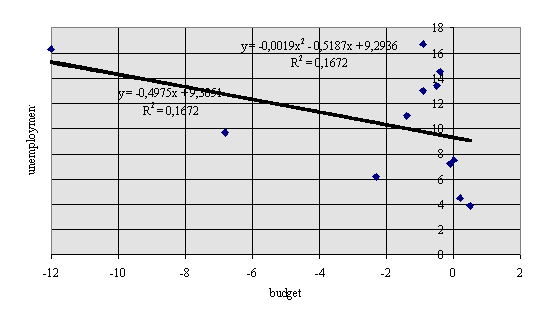
Legend: government budget balance (x-axis) and unemployment (y-axis). Data: Economist, 1998
Graph 9.24: unemployment and inflation - the evidence from Eastern Europe and the former USSR
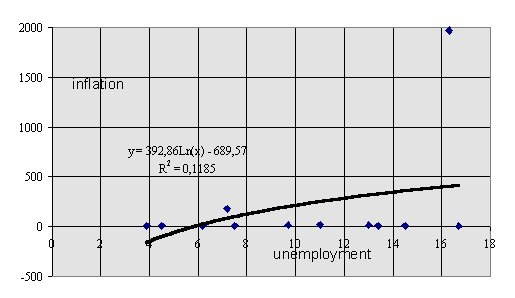
Legend: unemployment (x-axis) and inflation (y-axis). Data: Business Central Europe, current issues
Thirdly, current account balances determine only to a certain extent international reserves, and indeed, excess reserves are a good signal for money-laundering processes taking place in the economy, but such excess reserves dampen inflation. The transformation economy, successor to peripheral socialism 1945 - 1989, Nazi occupation 1938/39 - 1945 and peripheral capitalism 1450 - 1939, is characterized, as Amin teaches us, by a secular current account balance deficit, that has to be closed by almost any means - including imports of ‘illegal savings’. Like all wealth-owning capitalist classes, the crooks of Eastern Europe become very interested in financial stability and the canon of ‘property rights’, once their illegal money is parked. The right-hand upper outlayers in our following graph - the Czech Republic, Hungary, Poland, Slovakia, all have nowadays a much higher proportion of foreign currency reserves to their GDP as one might expect from the current account balance. Only the first, rising parts of our curves - or the straight fitting line - correspond to economic wisdom, while much of the rest is due to the global casino of money laundering and capital flight:
Graph 9.25: reserves and current account balances in the world system
1) Eastern Europe
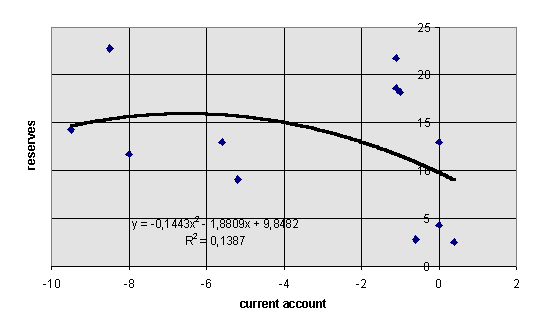
Legend: current account balance (in $ bn) (x-axis) and currency reserves (in $ bn) (y-axis). Data: Business Central Europe, current issues
2) developed western democracies
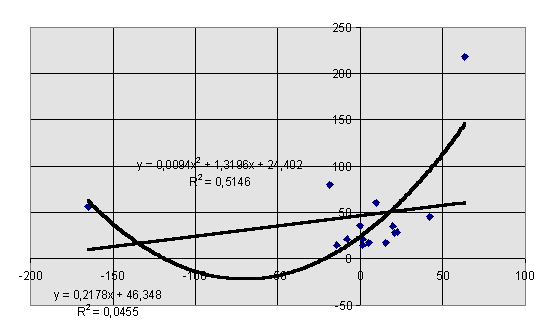
Legend: see above; source: Fischer Weltalmanach and UNDP
3) developing countries
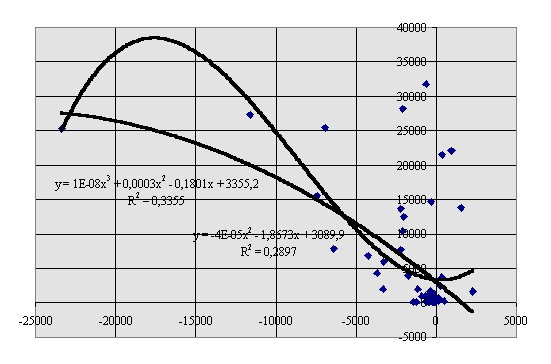
Legend: see above.
Eastern European inflation, to a great part, is also linked to the problem of illegal capital inflows that boost reserves in excess of the available current account balances, contributing to a dampening of the inflation process in the semi-periphery:
Graph 9.26: ‘excess reserves’ (money-laundering) and inflation
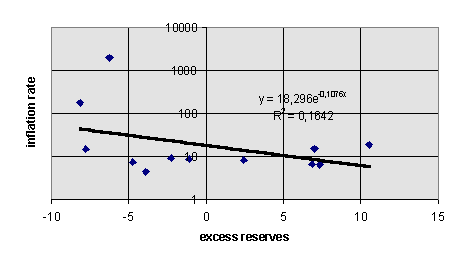
Legend: regression residuals from Graph 9.25 1), above (x-axis) and the inflation rate (y-axis). As to the data sources, see 9.25; plus EXCEL non-linear trend-line projections and residual value calculations. Put in simple terms: the more ‘unaccounted’ and ‘strange’ reserve currency inflows, the lower is the inflation rate.
Thus, one might say, that the stability of the East European exchange rates depends on these very same huge semi-legal and illegal reserves, that were accumulated by the opening of the twin Pandora’s boxes of open borders and liberalized world financial markets:
Table 9.14: stability conditions of Eastern currencies
|
inflation |
current acc |
reserves |
debt |
growth |
constant |
|
-177,34449 |
-36,68374 |
204,515725 |
15,3515777 |
0,35514332 |
-1558,1171 |
|
117,86279 |
41,2055865 |
104,321881 |
129,842067 |
1,40047248 |
850,153922 |
|
0,60849828 |
|||||
|
1,86512062 |
6 |
||||
|
-1,504669 |
-0,8902613 |
1,9604298 |
0,1182327 |
0,25358822 |
T-test |
|
inflation |
current acc |
reserves |
debt |
growth |
constant |
Legend: as in all EXCEL 5.0 outprints in this work, first row: unstandardized regression coefficients, second row: standard errors, last row: t-Test. The values immediately below the standard errors are R^2 (third row, left side entry), F, and degrees of freedom (fourth row).
But dependency becomes decisive, when long-term growth perspectives of East and Central European economies are being determined. There are indeed ‘the balance of payments constraints’ on economic growth: not only the stability of the Eastern currency, but also short-term Eastern economic growth becomes largely dependent on the import of ‘narco’ and other laundered money, that neatly shows up in the international reserves statistics (see also Chapter 8 for the contradicting results on a more long-term basis at the level of the world system).
Table 9.15: the balance of payments constraint on economic growth in the transformation states
|
budget |
unemployment |
inflation |
current acc |
reserves |
constant |
|
0,04146493 |
0,04189921 |
0,00122375 |
0,15937235 |
1,42604392 |
2,90491826 |
|
0,13145571 |
0,24323974 |
0,00246502 |
0,19867407 |
0,43335864 |
2,98086477 |
|
0,86923249 |
2,40001513 |
||||
|
7,97659149 |
6 |
||||
|
229,728731 |
34,5604357 |
||||
|
0,31542889 |
0,17225476 |
0,49644786 |
0,80217993 |
3,29067843 |
0,97452199 |
|
budget |
unemployment |
inflation |
current acc |
reserves |
constant |
Legend: as in all EXCEL 5.0 outprints in this work, first row: unstandardized regression coefficients, second row: standard errors, last row: t-Test. The values immediately below the standard errors are R^2 (third row, left side entry), F, and degrees of freedom (fourth row).
One plausibility is, of course, that the Central and East European economies, sandwiched by the process of negative current account balances and the march of the shadow-economy, will return to a process of arms manufacturing and arms exporting, which was one of the backbones of their economies in the 1980s and before. A time-series analysis of US ACDA data shows this hypothesis to be not without foundations:
Graph 9.27: towards a resumption of the arms exporting mechanisms in Eastern Europe? - The Polish case re-considered
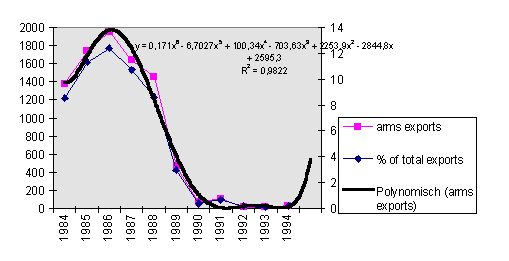
Legend: total arms exports (in constant US $, 1987) and the share of arms exports per total exports (right-hand scale), as well as the polynomial function fitted by the EXCEL program to the data series (trend-line). The function leaves less than 2% of arms exports unaccounted for. Our own compilations from the US ACDA web-site.
Fallacy eight is to overlook that in the long run, the stability of the capitalist system needs labor as an organized, countervailing power, that the very EURO process, as it is now underway, is about to put into question. In the developed capitalist countries, the empirical relationships suggest a new, labor-oriented approach to stabilization policy. Our Aristotelean message of a middle course is: at least a medium-level unionization rate and earnings growth rate will be necessary to stabilize capitalism, while at the same time the empirical support for a shortening of the weekly working hours as a way out of the crisis is rather weak.